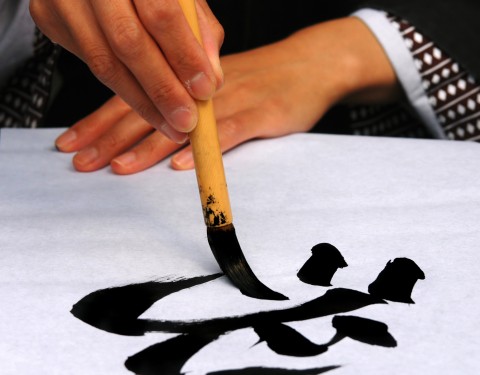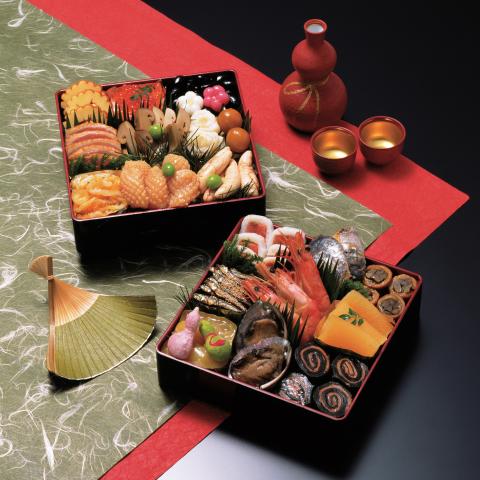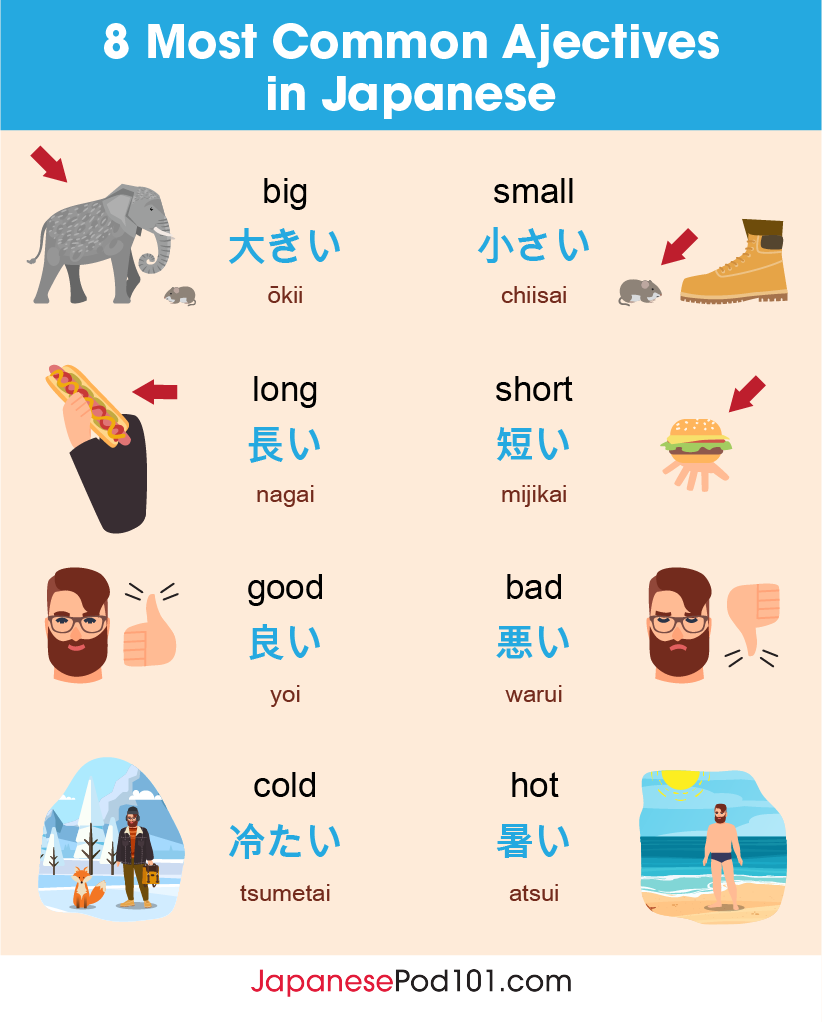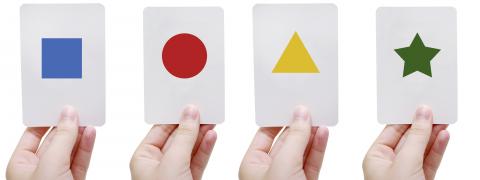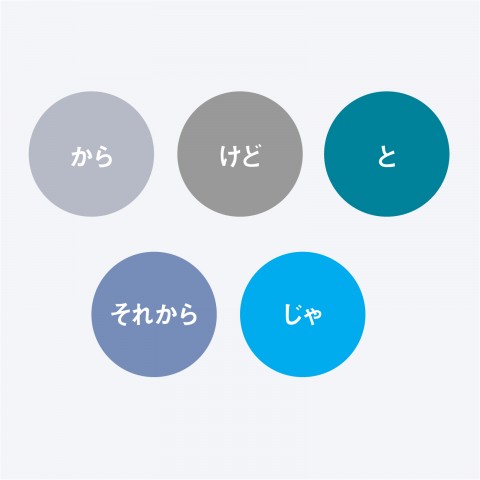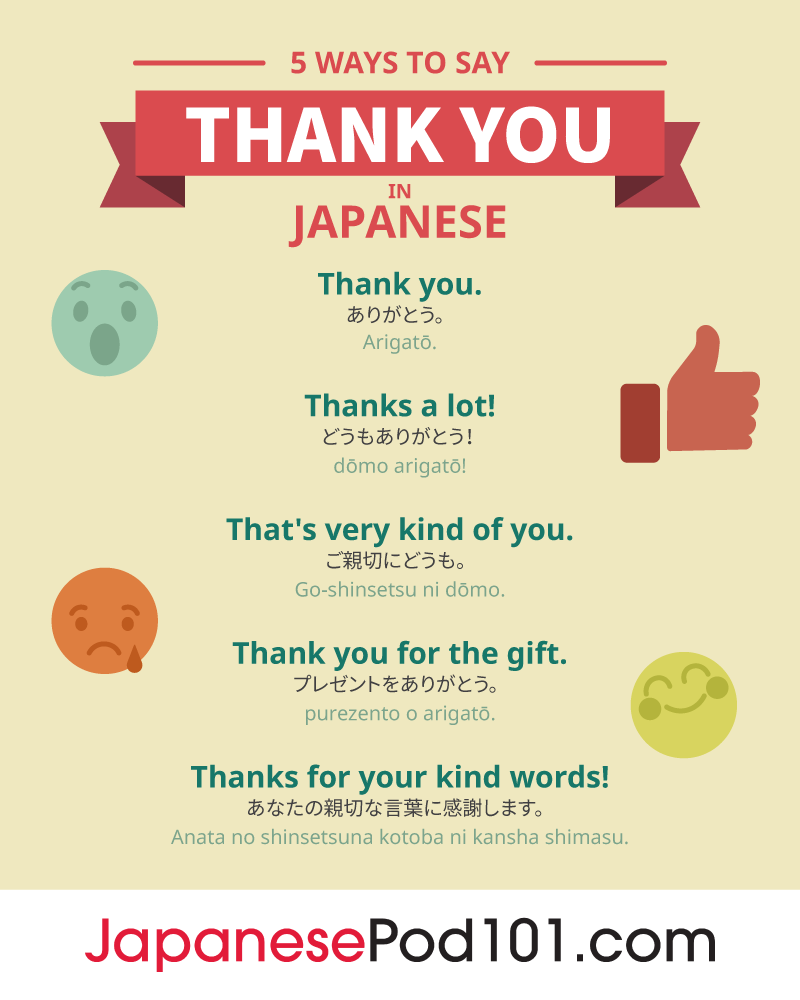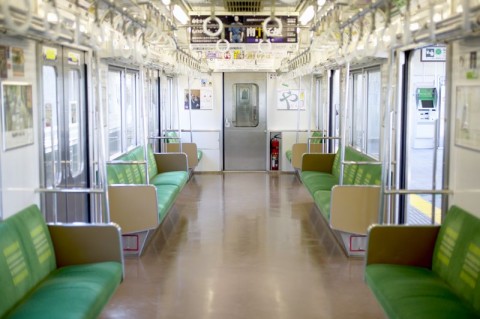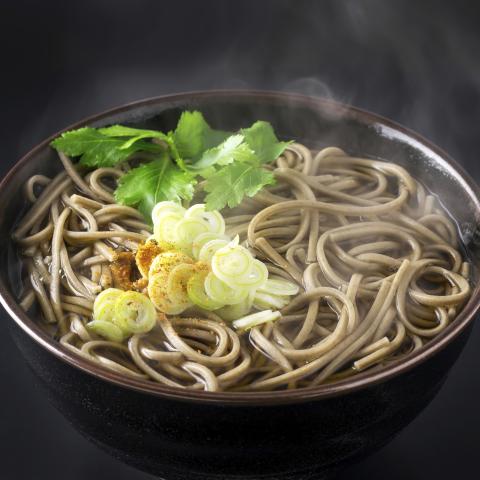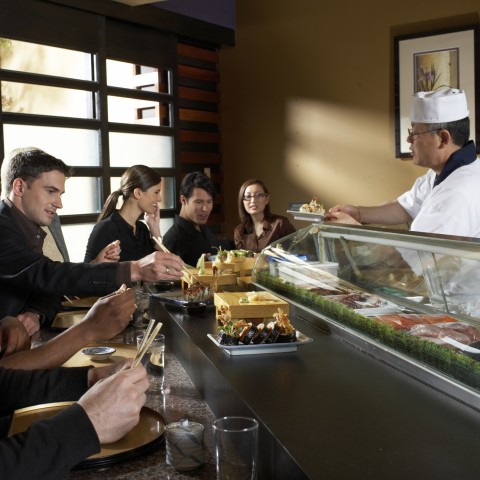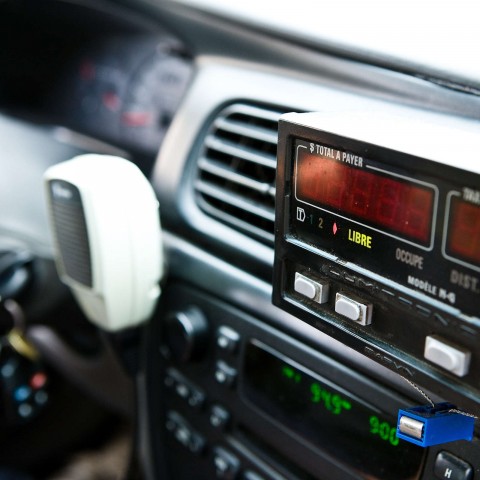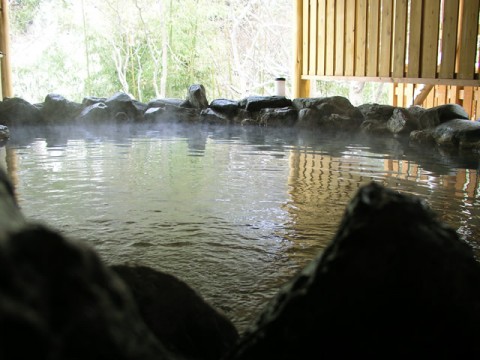
When learning a new language, the grammatical part is inevitable. Even if you have a large vocabulary and can communicate well enough with native speakers of that language (which is a great way to practice at first!), you need to know the correct word order and sentence structure to continue improving.
Japanese grammar is totally different from English grammar. However, once you get used to the Japanese sentence structure, it will be much easier for you to make sentences. This is because the Japanese language word order is more flexible than that of English.
In this article, we’ll introduce the basics of Japanese word order, which will help you better understand Japanese sentence structure as a whole. Brush up on your Japanese here at JapanesePod101.com!
 Table of Contents
Table of Contents
- Overview of Word Order in Japanese
- The Basic Word Order of Japanese
- Word Order with Postpositional Phrases
- Word Order with Modifiers
- Asking Questions
- Let’s Practice Making a Sentence in Japanese!
- Conclusion: How JapanesePod101 Can Help You Learn More Japanese
1. Overview of Word Order in Japanese

1. Japanese is SOV
Japanese is an SOV language, which means that the basic word order in a sentence is S (subject) – O (object) – V (verb). English, on the other hand, is an SVO language with the order of S (subject) – V (verb) – O (object).
(S) (O) (V)
Japanese: 私は本を読みます。(Watashi wa hon o yomimasu.)
(S) (V) (O)
English: “I read the book.”
2. Variable/Flexible Sentence Structure
The Japanese sentence structure is flexible:
[1] The subject can be omitted when it’s clear from the context/situation.
[2] The subject and object(s) can be placed in a variable order.
[1]
(S) (O) (V)
(私は)本を読みます。 [(Watashi wa) hon o yomimasu.] = “I read the book.”
The subject 私は (watashi wa) can be omitted.
[2]
(S) (V) (O)
English: “I read the book.”
In English, the subject can’t be omitted and the verb comes before the object.

(S) (O) (V)
Japanese: (私は) 本を読みます。 [(Watashi wa) hon o yomimasu.]
In Japanese, the subject can be omitted and the verb is always at the end of a sentence. The basic word order in Japanese is variable in that the subject can also appear after the object, and the order of the objects (if there are multiple) is flexible.

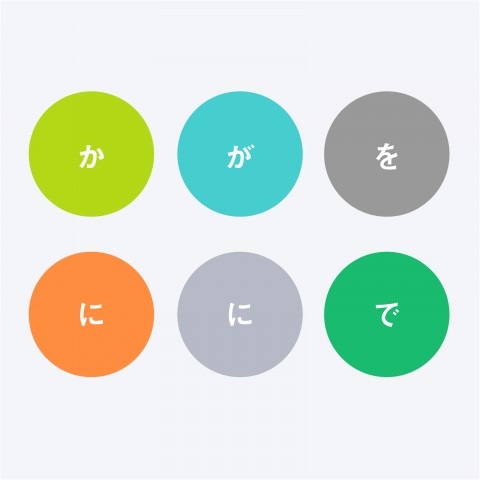
The postpositional particles are used in a Japanese sentence to modify words.
3. The Distinguishable Features of Word Order in Japanese Sentences
Compared to English, one of the distinguishable features of word order in Japanese is that Japanese has a 述語 (Jyutsugo), grammatically translated as “predicate.”
The predicate is one of the two main parts of a sentence stating something about the subject. While an English predicate can appear in the middle of a sentence, a Japanese 述語 (Jyutsugo) is always placed at the end of a sentence. This applies to both the casual form and the polite form.
Japanese: 私は本を読みます。(Watashi wa hon o yomimasu.) >> 読みます(yomimasu) is the predicate.
English: “I read the book.” >> “read the book” is the predicate.
2. The Basic Word Order of Japanese

1. SOV in Japanese
As we saw in the previous section, the basic sentence structure of Japanese is S (subject) – O (object) – V (verb).
Japanese parts of speech are usually followed by 助詞 (Joshi), or “particles,” that modify the word in front.
The subject is the person or thing that’s being discussed or described in a sentence, and the Japanese subject is usually followed by は (wa) or が (ga), which are 格助詞 (Kaku-Joshi) meaning “case markers” or 係助詞 (Kakari-Joshi) meaning “binding particles.”
The object is usually a noun or pronoun that is acted upon by the subject. A Japanese object is followed by a particle, such as を (o) or に (ni), which are 格助詞 (Kaku-Joshi).
The verb conveys an action (eat, write, move, etc.), an occurrence (happen, change), or a state of being (be, seem, exist). Japanese verbs either end the sentence, or are followed by 丁寧体 (Teinei-tai) such as です (desu) or ます (masu) in the polite form.
| Word Order | SVO : English (subject)-(verb)-(object) |
| Example | “I read the book.” |
| “I am a musician.” | |
| “The book is about music.” |
| SOV : Japanese (subject)-(object)-(verb) | Literal translation following the word order |
| 私は本を読みます。 Watashi wa hon o yomimasu. | I / the book / read. |
| 私は音楽家です。 Watashi wa ongakuka desu. | I / a musician / am. |
| その本は音楽についてです。 Sono hon wa ongaku ni tsuite desu. | The book / the music / about / is. |
2. Flexible Word Order
As we mentioned earlier, in Japanese grammar, word order is pretty flexible. Look at the diagram of the Japanese sentence structure in 1. 2. [2] above; the word order of the subject and object(s) is flexible. Even though the subject usually appears at the beginning of a sentence, the subject can also be placed in the middle or even be omitted.
Let’s take a look at the example.
S (subject) – O (object) – V (verb)
- (私は)明日図書館で友達と本を読みます。
(Watashi wa) ashita toshokan de tomodachi to hon o yomimasu.
(I) (tomorrow) (at the library) (with a friend) (the book) (read).
“I will read the book with a friend at the library tomorrow.”
The subject and object(s) can be placed in a variable order.
For example, the sentence above can also be in the following orders:
(私は)図書館で明日友達と本を読みます。
(Watashi wa) toshokan de ashita tomodachi to hon o yomimasu.
(私は)友達と図書館で明日本を読みます。
(Watashi wa) tomodachi to toshokan de ashita hon o yomimasu.
明日図書館で(私は)友達と本を読みます。
Ashita toshokan de (watashi wa) tomodachi to hon o yomimasu.
3. Word Order with Postpositional Phrases
While English uses prepositions (such as “at,” “on,” and “for”) to express a relationship to another word, Japanese uses postpositional particles, or 助詞 (Joshi). These particles come after the modified noun, verb, adjective, or at the end of a sentence.
There are several types of particles, categorized by function. However, we’ll only introduce the most essential particle: 格助詞 (Kaku-Joshi) or “case maker.”
When there are multiple objects, their order is flexible and variable as mentioned in the previous section.
| Meaning/Function | Reading | Hiragana | Example |
|---|---|---|---|
| Nominative case | -ga | ーが | 彼女が一番です。 Kanojo ga ichi-ban desu. “She is number one.” |
| Location | -de | ーで | ここで食べます。 Koko de tabemasu. “(I) eat here.” |
| Destination | -e | ーへ | 彼は図書館へいきます。 Kare wa toshokan e ikimasu. “He goes to the library.” |
| Dative case / Time | -ni | ーに | Dative: 彼は子供に本をあげました。 Kare wa kodomo ni hon o agemashita. “He gave the kid a book.” Time: 私は5時に出発します。 Watashi wa go-ji ni shuppatsu shimasu. “I depart at five o’clock.” |
| Origin | -kara | ーから | 駅は家から徒歩5分です。 Eki wa ie kara toho go-fun desu. “The station is a five-minute walk from home.” |
| Co-participant | -to | ーと | 彼女は彼と歌います。 Kanojo wa kare to utaimasu. “She sings with him.” |
| Objective case | -o | ーを | 私は本を読みます。 Watashi wa hon o yomimasu. “I read the book.” |
| Possessive case | -no | ーの | これは私のカバンです。 Kore wa watashi no kaban desu. “This is my bag.” |
| End point | -made | ーまで | 彼は駅まで歩きました。 Kare wa eki made arukimashita. “He walked to the station.” |
| Starting point / Comparative | -yori | ーより | Starting point: 会議は9時より行われます。 Kaigi wa ku-ji yori okonawaremasu. “The meeting will be held at nine o’clock.” Comparative: これはあれより安いです。 Kore wa are yori yasui desu. “This is cheaper than that.” |

彼は駅まで歩きました。(Kare wa eki made arukimashita.), “He walked to the station.”
4. Word Order with Modifiers
With the basic Japanese word order rules in mind, let’s see how it works with modifiers to make more complex sentences.
A modifier is a word—such as an adjective, pronoun, or adverb—that expresses something about the word that follows it. Adjectives and pronouns modify nouns; adverbs modify verbs.
Here’s the Japanese word order with modifiers by function.
1. With Adjectives
In Japanese word order, adjectives come in front of nouns to describe them.
- 赤いりんご (akai ringo), “red apple”
- 分厚い本 (buatsui hon), “thick book”
In a sentence with a subject and verb, the format is: S (subject) – O (object) – V (verb).
- 彼は赤いりんごを食べました。(Kare wa akai ringo o tabemashita.), “He ate a red apple.”
- 私は分厚い本を読みます。(Watashi wa buatsui hon o yomimasu.), “I read the thick book.”
To learn more about Japanese adjectives, please visit our page on the Most Common Adjectives.
2. With Possessive Pronouns
Japanese possessive pronouns—such as 私の (watashi no) meaning “my” and 彼の (kare no) meaning “his”—come in front of nouns. The Japanese possessive case is の (-no) which is the postpositional particle marked after a person or thing.
- 私の車 (Watashi no kuruma), “my car”
- 彼女の家 (Kanojo no ie), “her house”
In a sentence with a subject and verb:
- 彼は私の車を使いました。(Kare wa watashi no kuruma o tsukaimashita.), “He used my car.”
- 私は彼女の家へ行きました。(Watashi wa kanojo no ie e ikimashita.), “I went to her house.”
3. With Adverbs
Adverbs modify verbs, adjectives, or other adverbs. Japanese adverbs come in front of the words they modify.
- 静かに話します (shizuka ni hanashimasu), “speak quietly”
- ひどく疲れました (hidoku tsukaremashita), “terribly tired”
In a sentence with a subject and verb:
- 彼女は静かに話します。(Kanojo wa shizuka ni hanashimasu.), “She speaks quietly.”
- 彼女はとても静かに話します。(Kanojo wa totemo shizuka ni hanashimasu.), “She speaks very quietly.”
- 私はひどく疲れました。(Watashi wa hidoku tsukaremashita.), “I got terribly tired.”
For more about Japanese adverbs, please check out our page on Must-Know Adverbs and Phrases for Connecting Thoughts.
4. With Numerals
When numerals modify a noun, they come before that noun. When numerals are used as an object, they come before verbs.
- 一冊の本 (Issatsu no hon), “one book”
- 二つのりんご (Futatsu no ringo), “two apples”
- 5匹います (Go-hiki imasu), “there are five (kinds of animals)”
In a sentence with a subject and verb:
- 私は1冊の本を読みます。(Watashi wa issatsu no hon o yomimasu.), “I read one book.”
- 木から落ちたのは二つのりんごです。(Ki kara ochita no wa futatsu no ringo desu.), “What fell from a tree are two apples.”
- 動物園にパンダが5頭います。(Dōbutsuen ni panda ga go-tō imasu.), “There are five pandas in the zoo.”
There’s a great variety of Japanese counter words which are used when talking about things, actions, or events.
For more about the basics of Japanese numbers, please visit Numbers and Kanji for Numbers and Counters.

Dōbutsuen ni panda ga go-tō imasu. (“There are five pandas in the zoo.”)
5. Asking Questions
Making an interrogative sentence in Japanese is surprisingly easy! It doesn’t involve changing the word order or adding an auxiliary verb to form a question, like in English (e.g. You swim. >> Do you swim?).
In Japanese, you only have to add か (ka), a question marker, to the end of a sentence and pronounce it with a rising intonation.
Polite / Basic Sentence
- 私は本を読みます。(Watashi wa hon o yomimasu.), “I read the book.”
Question: 私は本を読みますか。 (Watashi wa hon o yomimasu ka.), “Do I read the book?”
- これは100円です。(Kore wa hyaku-en desu.), “This is 100 yen.”
Question: これは100円ですか。 (Kore wa hyaku-en desu ka.), “Is this 100 yen?”
- 彼女は肉を食べません。(Kanojo wa niku o tabemasen.), “She doesn’t eat meat.”
Question: 彼女は肉を食べませんか。(Kanojo wa niku o tabemasen ka.), “Doesn’t she eat meat?”
Casual Sentence
In casual and colloquial speech, just change the pronunciation to have a rising intonation at the end of a sentence, without adding か (ka).
- 今日は寒い。(Kyō wa samui.), “Today is cold.”
Question: 今日は寒い? (Kyō wa samui?), “Is today cold?”
- 私に小包が届いた。(Watashi ni kozutsumi ga todoita.), “The parcel was delivered to me.”
Question: 私に小包が届いた? (Watashi ni kozutsumi ga todoita?), “Was the parcel delivered to me?”
- (あなたは)犬が好き。[(Anata wa) inu ga suki.], “You like dogs.”
Question:(あなたは)犬が好き? [(Anata wa) inu ga suki?], “Do you like dogs?”
6. Let’s Practice Making a Sentence in Japanese!
Learning by doing is the best way to master! Now, let’s practice making a Japanese sentence, step by step, with the Japanese word order rules you’ve learned today. If you don’t remember anything, feel free to review the sections above!
Try to translate the following sentences in Japanese.
1. “You went to the library.” : _________________
2. “You went to the library in the morning.” : _________________
3. “You went to the library in the morning at eight o’clock.” : _________________
4. “Did you go to the library in the morning?” : _________________
5. “She ate sushi today.” : _________________
6. “She ate sushi with Mariko today.” : _________________
7. “She ate sushi with Mariko for lunch today.” : _________________
8. “Did she eat sushi with Mariko for lunch today?” :_________________
If you don’t know certain vocabulary words, please check out our lists for the 50 Most Common Verbs and our School Vocabulary.

“Library” in Japanese is 図書館 (toshokan).
[Answers]
1. “You went to the library.”
あなたは図書館へ行きました。(Anata wa toshokan e ikimashita.)
2. “You went to the library in the morning.”
あなたは朝図書館へ行きました。(Anata wa asa toshokan e ikimashita.)
3. “You went to the library in the morning at eight o’clock.”
あなたは朝8時に図書館へ行きました。(Anata wa asa hachi-ji ni toshokan e ikimashita.)
4. “Did you go to the library in the morning?”
あなたは朝図書館へ行きましたか。(Anata wa asa toshokan e ikimashita ka.)
5. “She ate sushi today.”
彼女は今日寿司を食べました。(Kanojo wa kyō sushi o tabemashita.)
6. “She ate sushi with Mariko today.”
彼女は今日まりこと寿司を食べました。(Kanojo wa kyō Mariko to sushi o tabemashita.)
7. “She ate sushi with Mariko for lunch today.”
彼女は今日お昼ご飯にまりこと寿司を食べました。(Kanojo wa kyō o-hirugohan ni Mariko to sushi o tabemashita.)
8. “Did she eat sushi with Mariko for lunch today?” :
彼女は今日まりこと寿司を食べましたか。(Kanojo wa kyō Mariko to sushi o tabemashita ka.)
*The word order of objects can vary when there are many in a sentence.
7. Conclusion: How JapanesePod101 Can Help You Learn More Japanese
In this article, we introduced you to Japanese word order. Now you understand how the Japanese sentence structure works. At first, you might feel confused about the flexibility of Japanese word order, but you’ll find it’s actually a lot easier to make complex sentences once you get used to it!
If you would like to learn more about the Japanese language and practice other useful Japanese phrases for any situation, you’ll find a lot more helpful content on JapanesePod101.com. We provide a variety of free lessons to help you improve your Japanese language skills. Here’s some more information about the basics of Japanese with audio: Top 10 Sentence Patterns for Beginners and Most Useful Pronouns.
And there’s so much more we can offer you! Learn faster and enjoy studying Japanese at JapanesePod101.com!
Before you go, let us know in the comments if you still have questions about Japanese word order. We’d be glad to help.

How to Tell Time in Japanese

Telling time is one of the most essential aspects of everyday life. Learning how to tell time in Japanese will help you improve your basic Japanese language skills. Whether you’re checking the time for transportation or making an appointment, knowing how to say time in Japanese will help you when visiting Japan.
Telling time in Japanese is quite simple and easy to understand. Unlike in English, when expressing time in Japanese, the words which indicate the hour and minute are always added next to the numbers (e.g. 3:12 or three twelve = 時 (3ji) 分 (12fun). Thus, even without context or a sentence, you’ll easily understand that these phrases indicate time in Japanese.
In this article, we introduce the basic vocabulary and phrases for telling time in Japanese. Let’s get started!
 Table of Contents
Table of Contents
- How to Ask for the Time
- Telling Time in Japanese: Hours
- Telling Time in Japanese: Minutes
- The Hours Divided into Minutes
- General Time Reference of the Day
- Adverbs of Time in Japanese
- Time Proverbs and Sayings
- Conclusion: How JapanesePod101 Can Help You Learn More Japanese
1. How to Ask for the Time

Here’s a list of the most typical phrases for asking about time in Japanese.
1- What time is it now?
Japanese: 今何時ですか。
Reading: Ima nan-ji desu ka.
- すみません、今何時ですか。
Sumimasen, ima nan-ji desu ka.
Excuse me, what time is it now?
2- Do you know the time now?
Japanese: 今何時かわかりますか。
Reading: Ima nan-ji ka wakarimasu ka.
- ちょっといいですか、今何時かわかりますか。
Chotto ii desu ka, ima nan-ji ka wakarimasu ka.
Can I talk to you a bit? Do you know the time now?
3- What time is the [e.g. meeting]?
Japanese: [会議] は何時ですか。
Reading: [Kaigi] wa nan-ji desu ka.
- 田中さん、到着は何時ですか。
Tanaka-san, tōchaku wa nan-ji desu ka.
Mr. (Ms.) Tanaka, what time is the arrival?
4- What time do we meet up?
Japanese: 何時に集合ですか。
Reading: Nan-ji ni shūgō desu ka.
- すみません、7月10日は何時に集合ですか。
Sumimasen, shichi-gatsu tōka wa nan-ji ni shūgō desu ka.
Excuse me, what time do we meet up on July 10?
To learn dates in Japanese, please visit our Reading Dates in Japanese article.

Japanese people are famous for being on time.
2. Telling Time in Japanese: Hours
When speaking, the twelve-hour clock is more commonly used; when written, either the twelve-hour clock or the twenty-four-hour clock is used for telling time in Japanese.
When using the twelve-hour clock, add 午前 (gozen) meaning “a.m.” or 午後 (gogo) meaning “p.m.” to clarify.
1- The Twelve-Hour Clock in Japanese
Add 時 (ji), meaning “hour” or “o’clock,” after the Japanese numbers. Keep in mind that Arabic numbers are commonly used.
| English | Kanji | Hiragana | Reading |
|---|---|---|---|
| 0 o’clock | 零時 | れいじ | rei-ji |
| 1 o’clock | 一時 | いちじ | ichi-ji |
| 2 o’clock | 二時 | にじ | ni-ji |
| 3 o’clock | 三時 | さんじ | san-ji |
| 4 o’clock | 四時 | よじ | yo-ji |
| 5 o’clock | 五時 | ごじ | go-ji |
| 6 o’clock | 六時 | ろくじ | roku-ji |
| 7 o’clock | 七時 | しちじ | shichi-ji |
| 8 o’clock | 八時 | はちじ | hachi-ji |
| 9 o’clock | 九時 | くじ | ku-ji |
| 10 o’clock | 十時 | じゅうじ | jū-ji |
| 11 o’clock | 十一時 | じゅういちじ | jū ichi-ji |
| 12 o’clock | 十二時 | じゅうにじ | jū ni-ji |
Please visit our Japanese Numbers article and Numbers page on JapanesePod101 to learn how to read numbers in Japanese.
2- Examples
- 昼食の時間は午後1時です。
Chūshoku no jikan wa gogo ichi-ji desu.
Lunch time is at one o’clock p.m.
- 会議は10時からですか。
Kaigi wa jū-ji kara desu ka.
Is the meeting at ten o’clock?
- 明日の朝7時に来てください。
Ashita no asa shichi-ji ni kite kudasai.
Please come at seven o’clock tomorrow morning.
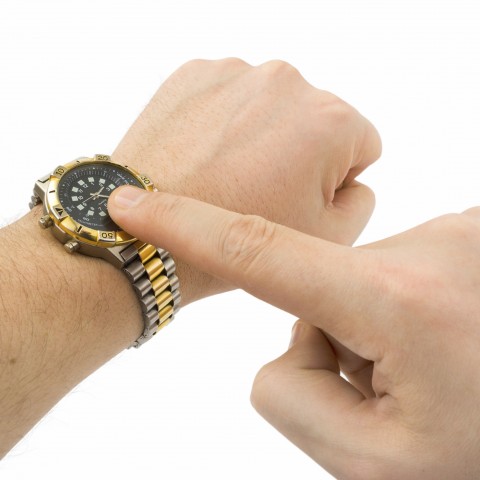
Toki wa kane nari (Time is money).
3. Telling Time in Japanese: Minutes
1- Minutes in Japanese
Unlike in English, 分 (fun) or (pun) meaning “minute” is always added after the numbers when telling minutes in Japanese.
- “Minute(s)” in Japanese is 分 and it’s pronounced either fun or pun depending on which number comes before 分.
- Minutes are usually written with Arabic numbers rather than Kanji.
| English | Kanji | Hiragana | Reading |
|---|---|---|---|
| 1 minute | 一分 | いっぷん | ippun |
| 2 minutes | 二分 | にふん | ni-fun |
| 3 minutes | 三分 | さんぷん | san-pun |
| 4 minutes | 四分 | よんふん | yon-fun |
| 5 minutes | 五分 | ごふん | go-fun |
| 6 minutes | 六分 | ろっぷん | roppun |
| 7 minutes | 七分 | ななふん | nana-fun |
| 8 minutes | 八分 | はっぷん | happun |
| 9 minutes | 九分 | きゅうふん | kyū-fun |
| 10 minutes | 十分 | じゅっぷん | juppun |
| 20 minutes | 二十分 | にじゅっぷん | ni-juppun |
| 30 minutes | 三十分 | さんじゅっぷん | san-juppun |
| 40 minutes | 四十分 | よんじゅっぷん | yon-juppun |
| 50 minutes | 五十分 | ごじゅっぷん | go-juppun |
2- Examples
- 地震は朝9時24分に起きました。
Jishin wa asa ku-ji ni-jū yon-fun ni okimashita.
The earthquake occurred at 9:24 in the morning.
- 次の電車は3時47分に来ます。
Tsugi no densha wa san-ji yon-jū nana-fun ni kimasu.
The next train comes at 3:47.
- 今の時間は午後6時18分です。
Ima no jikan wa gogo roku-ji jū happun desu.
The current time is 6:18 p.m.

It is jū-ji jū ippun (10:11) in Japanese.
4. The Hours Divided into Minutes
Telling time with minutes in Japanese is quite simple and there are no special terms or phrases to express certain groups of minutes, except for 半 (han) meaning “half.” On the other hand, English has more specific expressions, such as “quarter,” “XX past two (XX minutes after two o’clock),” and “XX to seven (XX minutes before seven o’clock).”
- To express “thirty minutes past XX o’clock” in Japanese, just add 半 (han), meaning “half,” after “number + 時 (ji).”
- There’s no particular word for “quarter” when telling time in Japanese. It‘s simply “fifteen minutes”: 15分 (jū go-fun).
- “Five past six,” or 6:05, is 6時5分 (roku-ji go-fun) in Japanese.
- “Ten to seven” is 7時10分前 (shichi-ji juppun mae) in Japanese, which literally means “Ten minutes before seven o’clock.”
Examples
- 飛行機は朝8時半に出発します。
Hikōki wa asa hachi-ji han ni shuppatsu shimasu.
The airplane departs at 8:30 in the morning.
- 明日の会議は3時15分前に来てください。
Ashita no kaigi wa san-ji jū go-fun mae ni kite kudasai.
Please come to tomorrow’s meeting fifteen minutes before three o’clock.
- 今の時間は9時10分前です。
Ima no jikan wa ku-ji juppun mae desu.
The current time is ten minutes before nine o’clock.
- あの学校は朝6時半に開きます。
Ano gakkō wa asa roku-ji han ni akimasu.
That school opens at 6:30 in the morning.
5. General Time Reference of the Day
What if you want to give a nonspecific or approximate time in Japanese? Here’s some basic vocabulary for describing time in Japanese based on the general time of day.
| English | Kanji | Hiragana | Reading |
|---|---|---|---|
| AM | 午前 | ごぜん | gozen |
| PM | 午後 | ごご | gogo |
| morning | 朝 | あさ | asa |
| early morning | 早朝 | そうちょう | sōchō |
| sunrise | 日の出 | ひので | hinode |
| noon | 正午 | しょうご | shōgo |
| midday | 日中 | にっちゅう | nicchū |
| early evening | 夕方 | ゆうがた | yūgata |
| sunset | 日没 | にちぼつ | nichibotsu |
| evening / night | 夜 | よる | yoru |
| midnight | 深夜 | しんや | shin’ya |

The sunset time in summer is around seven o’clock p.m. in Japan.
Examples
- 夏の日の出は早朝の4時半です。
Natsu no hinode wa sōchō no yo-ji han desu.
The sunrise in summer is at 4:30 in the early morning.
- 明日の夜8時に夕食を食べましょう。
Ashita no yoru hachi-ji ni yūshoku o tabemashō.
Let’s have dinner at eight o’clock tomorrow evening.
- 私の飛行機は深夜12時3分に出発します。
Watashi no hikōki wa shin’ya jū ni-ji san-pun ni shuppatsu shimasu.
My flight departs at 12:03, at midnight.
- 私は今日正午から夕方まで忙しいです。
Watashi wa kyō shōgo kara yūgata made isogashii desu.
I’m busy from noon to early evening today.
6. Adverbs of Time in Japanese

You can create more-detailed and specific time-related expression by using time adverbs. Japanese adverbs of time include:
| English | Kanji | Hiragana | Reading |
|---|---|---|---|
| right now | 今すぐ | いますぐ | ima sugu |
| before | 前 | まえ | mae |
| after | 後 | あと/ご | ato/go |
| soon | ー | もうすぐ | mō sugu |
| soon | ー | ほとんど | hotondo |
| around | 頃 | ころ/ごろ | koro/goro |
| about | 約 | やく | yaku |
| currently | 現在 | げんざい | genzai |
| meanwhile | その間に | そのあいだに | sono aida ni |
| at the same time | 同時に | どうじに | dōji ni |
| at the same time | ー | いつでも | itsu demo |
| as soon as possible | 出来るだけ早く | できるだけはやく | dekirudake hayaku |
| in a while | 間もなく/しばらく | まもなく/しばらく | mamonaku/shibaraku |
| for a long time | 長い間 | ながいあいだ | nagai aida |
Examples
- 今すぐ来きてください。会議は15分後に始まります。
Ima sugu kite kudasai. Kaigi wa jū go-fun go ni hajimarimasu.
Please come right now. The meeting is starting after fifteen minutes.
- 同時に、別のパーティーが午後7時半から始まります。
Dōji ni, betsu no pātī ga gogo shichi-ji han kara hajimarimasu.
At the same time, another party will start at 7:30 p.m.
- 私は午前8時から長い間待っています。出来るだけ早くここへ来てください。
Watashi wa gozen hachi-ji kara nagai aida matte imasu. Dekirudake hayaku koko e kite kudasai.
I have been waiting for a long time, since 8 o’clock a.m. Come here as soon as possible.
- 今は午後2時58分で、もうすぐ3時になります。まもなく電車が来ます。
Ima wa gogo ni-ji go-jū happun de, mō sugu san-ji ni narimasu. Mamonaku densha ga kimasu.
It is 2:58 p.m. and it’s going to be 3:00 soon. The train comes in a while.

Japanese trains are very punctual.
7. Time Proverbs and Sayings
When talking about time in Japanese culture, there are many ことわざ (kotowaza) and 慣用句 (kan’yōku), or “proverbs” and “sayings” regarding time in Japanese. Here are some of the most famous proverbs.
- Time is money.
Japanese: 時は金なり
Reading: Toki wa kane nari
Meaning: It literally translates to “time is money,” and it means that time is as precious as money.
遅れないように! 「時は金なり」ですよ。
Okurenai yō ni! “Toki wa kane nari” desu yo.
Don’t be late! Time is money.
- Time flies.
Japanese: 光陰矢のごとし
Reading: Kōin ya no gotoshi
Meaning: It literally translates to “time is like an arrow,” meaning that time flies fast, like an arrow. The word 光陰 (Kōin) comes from 漢文 (Kanbun), an old Chinese word which denotes “light and shade,” meaning “time.” Thus, time goes by with days and nights.
前回会った時から既に5年経ちました。「光陰矢のごとし」ですね。
Zenkai atta toki kara sude ni go-nen tachimashita. “Kōin ya no gotoshi” desu ne.
Five years have already passed since we last met. Time flies, doesn’t it?
- Time and tide wait for no man.
Japanese: 歳月人を待たず
Reading: Saigetsu hito o matazu
Meaning: It literally translates to “years and months do not wait for man,” meaning that time goes by constantly without heeding one’s circumstances. It indicates that people shouldn’t waste time and should instead make each day count.
やるべき事ややりたい事は今すぐやりましょう。「歳月人を待たず」ですよ!
Yarubeki koto ya yaritai koto wa ima sugu yarimashō. ”Saigetsu hito o matazu” desu yo!
Do right now what you should do and what you want to do. It’s “time and tide wait for no man!”
- Each day is like a thousand years.
Japanese: 一日千秋
Reading: Ichijitsu senshū
Meaning: It literally translates to “one day is like a thousand autumns.” It means that one can hardly wait for something because it feels very far in the future, as if one day is like a thousand years (autumn comes a thousand times). 秋 (aki/shū) means “autumn,” but it also can mean “time” as a metaphor. It’s said that autumn is the time for harvest, and ancient people realized that a year had passed when autumn came.
彼女は来月行く予定のコンサートを一日千秋の思いで待っています。
Kanojo wa raigetsu iku yotei no konsāto o ichijitsu senshū no omoi de matte imasu.
She’s waiting for the concert she’s going to next month with the feeling that each day is like a thousand years.
8. Conclusion: How JapanesePod101 Can Help You Learn More Japanese
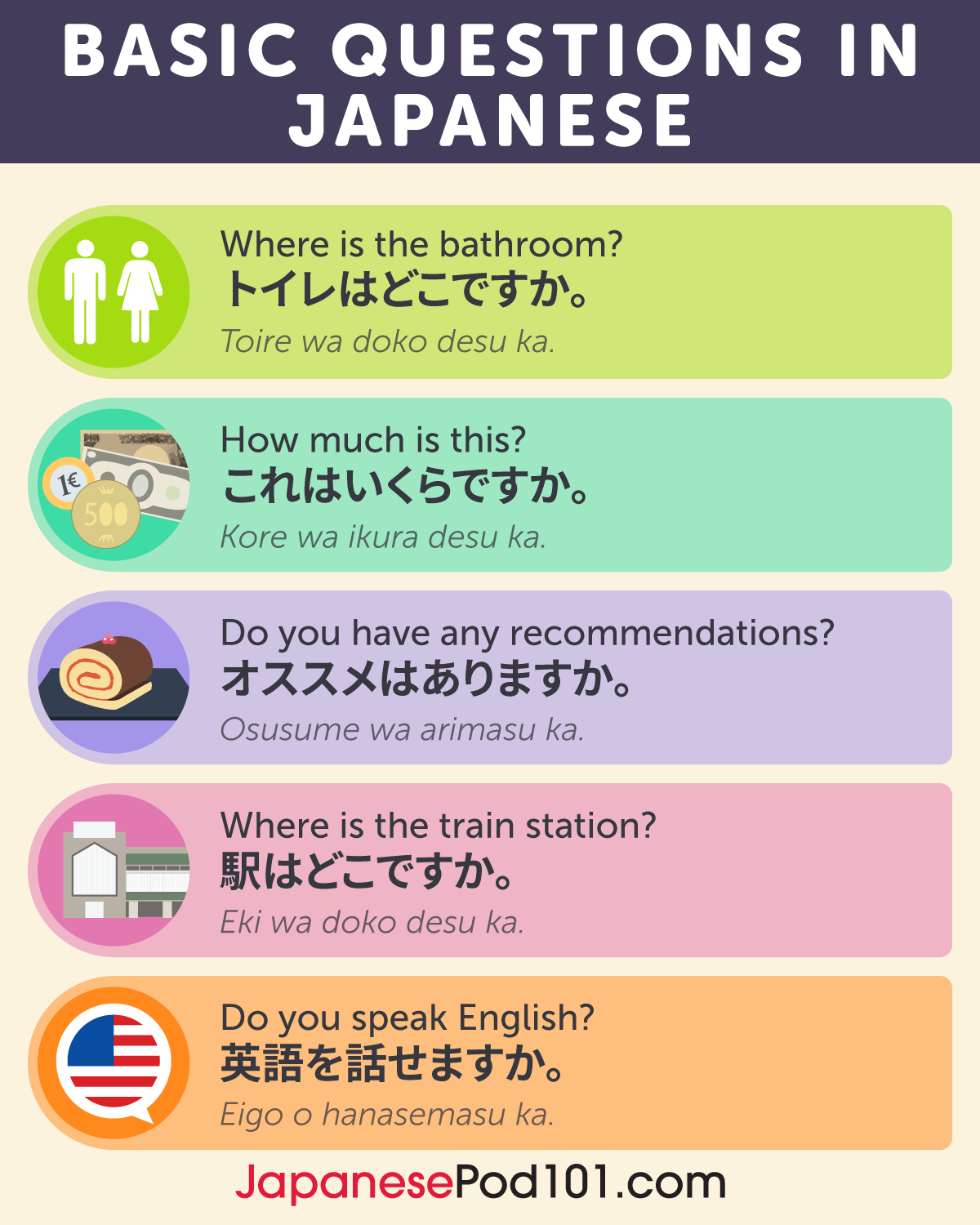
In this article, we introduced how to tell time in Japanese, including the basic vocabulary and phrases, such as the different units of time in Japanese. Now you can ask for the time and tell time in Japanese whenever you make an appointment or check times for your travels.
I hope you’ll enjoy meeting friends and getting around in Japan; make sure you’re on time when meeting them!
Are there any time-related words in Japanese you still want to know? Let us know in the comments!
If you would like to learn more about the Japanese language and other useful Japanese phrases, you’ll find a lot of helpful content on JapanesePod101.com. We provide a variety of free lessons for you to improve your Japanese language skills. Here’s some more information about numbers and time in Japanese with audio: Talking about Time, Numbers, and Kanji for Numbers and Counters.
To learn how to make conversation in Japanese, check out Top 15 Questions You Should Know for Conversations and Top 10 Conversational Phrases. Phrases You Need at the Bus or Train Station and Trains are also useful if you plan on getting around Japan with public transportation.
There’s so much more! Be a fast learner and enjoy studying Japanese at JapanesePod101.com!

Giving and Asking for Directions: “Right” in Japanese & More

Knowing how to ask for directions in Japanese is very helpful when it comes to getting around in Japan. In particular, finding the right address can be a bit confusing, because smaller streets in Japan aren’t named and addresses are expressed with the name of a small area and numbers.
Along with knowing how to ask directions in Japanese, understanding the directions you were told is even more important. This ensures that you can reach the destination with the information given. (You don’t want to mistake “right” in Japanese for left!)
But don’t worry! Japanese people are kind in general, and they’ll stop to listen and help you when you ask them for directions in Japanese.
Here’s some useful vocabulary and phrases for giving and asking for directions in Japanese. Master directions in Japanese at JapanesePod101.com and find your way to exciting destinations!

Table of Contents
- On the Map: Cardinal Directions in Japanese
- On the Road
- Giving Directions in Japanese Using Landmarks
- Must-Know Phrases for Asking for Directions in Japanese
- Must-Know Phrases for Giving Directions in Japanese
- Other Useful Phrases for Asking Directions with Map/Phone
- Conclusion: How JapanesePod101 Can Help You Learn More Japanese
1. On the Map: Cardinal Directions in Japanese

Let’s master the basic compass directions in Japanese for reading the map.
1- Basic Vocabulary
| Reading | Kanji | Hiragana | English |
| kita | 北 | きた | north |
| minami | 南 | みなみ | south |
| nishi | 西 | にし | west |
| higashi | 東 | ひがし | east |
| hokusei | 北西 | ほくせい | northwest |
| hokutō | 北東 | ほくとう | northeast |
| nantō | 南東 | なんとう | southeast |
| nansei | 南西 | なんせい | southwest |
| chizu | 地図 | ちず | map |
| genzaichi | 現在地 | げんざいち | current location |
2- Examples
- 皇居は現在地から北東へ5kmの場所にあります。
Kōkyo wa genzaichi kara hokutō e go-kiromētoru no basho ni arimasu.
The Imperial Palace is located 5km northeast from the current location. - 日本の地理は、北の北海道、東の関東、西の関西、南の九州が特徴です。
Nihon no chiri wa, kita no Hokkaidō, higashi no Kantō, nishi no Kansai, minami no Kyūshū ga tokuchō desu.
The geography of Japan is characterized by Hokkaidō of the North, Kantō of the East, Kansai of the West, and Kyūshū of the south. - 横浜は、東京の南に位置しています。
Yokohama wa Tōkyō no minami ni ichi shite imasu.
Yokohama is located in the south of Tokyo.
 The Japanese map shows the major roads with names, but small streets don’t have names. It’s useful to know the word kita, meaning “north” in Japanese, for reading the map.
The Japanese map shows the major roads with names, but small streets don’t have names. It’s useful to know the word kita, meaning “north” in Japanese, for reading the map.
2. On the Road
Knowing how to say directions in Japanese for the road, such as right and left in Japanese, is very useful. The vocabulary below is essential for giving and receiving driving directions in Japanese!1- Basic Vocabulary
| Reading | Kanji | Hiragana | English |
| mae | 前 | まえ | front |
| ushiro | 後ろ | うしろ | back |
| hidari | 左 | ひだり | left |
| migi | 右 | みぎ | right |
| tōi | 遠い | とおい | far |
| chikai | 近い | ちかい | close |
| koko | ー | ここ | here |
| asoko | ー | あそこ | there |
| massugu | ー | まっすぐ | straight |
| tonari | 隣 | となり | next |
| watatta | 渡った | わたった | across |
| kōsaten | 交差点 | こうさてん | intersection |
| kado o magaru | 角を曲がる | かどをまがる | turn the corner |
2- Examples
- 東京タワーは東京プリンスホテルの隣にあります。次の角を右に曲がって、まっすぐ進んでください。
Tōkyō Tawā wa Tōkyō Prince Hotel no tonari ni arimasu. Tsugi no kado o migi ni magatte, massugu susunde kudasai.
Tokyo Tower is located next to Tokyo Prince Hotel. Please turn right at the next corner and go straight. - 明治神宮は原宿駅から200mくらいの場所で、近いです。
Meiji Jingū wa Harajuku Eki kara ni-hyaku-mētoru kurai no basho de, chikai desu.
Meiji Jingū is located around 200m away from Harajuku Station and it is close. - 都庁のビルは、新宿中央公園から交差点を渡った場所にあります。
Tochō no biru wa, Shinjuku Chūō Kōen kara kōsaten o watatta basho ni arimasu.
The Tokyo Metropolitan Government Building is located across the intersection from Shinjuku Central Park. - あそこの交差点を左に曲がって道をまっすぐ行くと、前に駅が見えます。
Asoko no kōsaten o hidari ni magatte michi o massugu iku to, mae ni eki ga miemasu.
When you turn left at the intersection there, go straight on the street; you will see the station in front.

When you’re at an intersection or on a road, migi, meaning “right” in Japanese, and hidari, meaning “left” in Japanese, are essential words to use for giving/asking directions.
3. Giving Directions in Japanese Using Landmarks
A landmark is an object or feature of a landscape or city that’s easily seen and recognized from a distance. Know the basic vocabulary for landmarks will help you understand when you’re getting directions in Japanese.
1- In the City: Basic Vocabulary
| Reading | Kanji | Hiragana / Katakana | English |
| kūkō | 空港 | くうこう | airport |
| chikatetsu no ek | 地下鉄の駅 | ちかてつのえき | subway station |
| machi no chūshinchi | 街の中心地 | まちのちゅうしんち | center of the city |
| kōen | 公園 | こうえん | park |
| hoteru | ー | ホテル | hotel |
| byōin | 病院 | びょういん | hospital |
| ginkō | 銀行 | ぎんこう | bank |
Examples
- 地下鉄の駅は、この道をまっすぐ進むと、銀行の隣にあります。
Chikatetsu no eki wa, kono michi o massugu susumu to, ginkō no tonari ni arimasu.
The subway station is located next to the bank when you go straight on this road. - この街の中心地は駅の近くで、あそこの病院を右に曲がって500mくらいの場所にあります。
Kono machi no chūshinchi wa eki no chikaku de, asoko no byōin o migi ni magatte go-hyaku-mētoru kurai no basho ni arimasu.
The center of this city is located near the station, and it’s 500m away after you turn right at the hospital there. - この交差点を左に曲がると、地下鉄の駅があります。
Kono kōsaten o hidari ni magaru to, chikatetsu no eki ga arimasu.
When you turn left at this intersection, the subway station is there.
2- On the Road: Basic Vocabulary
| Reading | Kanji | Hiragana / Katakana | English |
| shingō | 信号 | しんごう | traffic light |
| ōdanhodō | 横断歩道 | おうだんほどう | crosswalk |
| kado | 角 | かど | corner |
| tatemono / biru | 建物 / ビル | たてもの / ビル | building |
| kōban / keisatsusho | 交番 / 警察署 | こうばん / けいさつしょ | police station |
| eki | 駅 | えき | train station |
| basutei | バス停 | バスてい | bus stop |
| hashi | 橋 | はし | bridge |
A 交番 こうばん (kōban) is a small police station in a community, and is the smallest unit of the police structure in Japan. On the other hand, a 警察署 けいさつしょ (keisatsusho) is a large police station which is usually the headquarters of the police station in a city or area.
Examples
- 駅は、あの横断歩道を渡って右にある高い建物の後ろにあります。
Eki wa, ano ōdanhodō o watatte migi ni aru takai tatemono no ushiro ni arimasu.
The train station is located at the back of the tall building on the right after crossing that crosswalk. - この道をまっすぐ進むと、左に交番が見えます。交番の角を右に曲がるとバス停があります。
Kono michi o massugu susumu to, hidari ni kōban ga miemasu. Kōban no kado o migi ni magaru to basutei ga arimasu.
When you go straight on this street, you will see the police station on your left. There is the bus stop after you turn right at the corner of the police station. - あの橋を渡って見える大きい建物は横浜ホテルです。
Ano hashi o watatte mieru ōkii tatemono wa Yokohama Hotel desu.
The big building you see across that bridge is Yokohama Hotel.
 Tokyo Tower is one of the most famous landmarks in Tokyo.
Tokyo Tower is one of the most famous landmarks in Tokyo.
3- In a Structure/Building: Basic Vocabulary
| Reading | Kanji | Hiragana / Katakana | English |
| iriguchi | 入口 | いりぐち | entrance |
| deguchi | 出口 | でぐち | exit |
| keshōshitsu / toire | 化粧室 / トイレ | けしょうしつ / トイレ | restroom |
| kaidan | 階段 | 階段 | stairs |
| erebētā | ー | エレベーター | elevator |
| mon | 門 | もん | gate |
| chūshajō | 駐車場 | ちゅうしゃじょう | parking lot |
Examples
- 地下鉄の駅の入口は、この階段を降りた右側にあります。
Chikatetsu no eki no iriguchi wa, kono kaidan o orita migigawa ni arimasu.
The entrance of the subway station is located at the right side after going down the stairs. - トイレはこのビルの3階にあります。あのエレベーターで3階に行けます。
Toire wa kono biru no san-kai ni arimasu. Ano erebētā de san-kai ni ikemasu.
There is a toilet on the third floor in this building. You can go to the third floor with that elevator. - あの駐車場の門の隣に出口があります。
Anochūshajō no mon no tonari ni deguchi ga arimasu.
There is an exit next to that gate in the parking lot.
 There are many exit gates in the large stations in Japan’s larger cities.
There are many exit gates in the large stations in Japan’s larger cities.
4. Must-Know Phrases for Asking for Directions in Japanese

Here’s a list of useful phrases and examples for how to ask for directions in Japanese.
1- Polite Phrases to Begin Your Question
すみません (sumimasen) — Excuse me
すみません、この駅の入口はどこですか。Sumimasen, kono eki no iriguchi wa doko desu ka.
Excuse me, where is the entrance to this station?
ちょっといいですか。(Chotto ii desu ka.) — Can I talk to you? / May I ask a bit?
ちょっといいですか。渋谷駅はどこですか。Chotto ii desu ka. Shibuya Eki wa doko desu ka.
Can I talk to you a bit? Where is Shibuya station?
助けてもらえますか。(Tasukete moraemasu ka.) — Will you help me?
助けてもらえますか。空港までの行き方を教えてくれませんか。Tasukete moraemasu ka. Kūkō made no ikikata o oshiete kuremasen ka.
Will you help me? Can you show me the way to go to the airport?
2- Example Phrases Using “Where is…?”
…はどこですか。(… wa doko desu ka.) — Where is …?
- すみません、トイレはどこですか。
Sumimasen, toire wa doko desu ka.
Excuse me, where is the toilet? - ちょっといいですか。代々木公園はどこですか。
Chotto ii desu ka. Yoyogi Kōen wa doko desu ka.
Can I talk to you? Where is Yoyogi Park? - すみません、お台場はどこですか。
Sumimasen, Odaiba wa doko desu ka.
Excuse me, where is Odaiba?
3- Example Phrases Using “How do I get to…?”
…にはどうやって行けばいいですか。 (… ni wa dō yatte ikeba ii desu ka.) — How do I get to…?
- 浅草にはどうやって行けばいいですか。
Asakusa ni wa dō yatte ikeba ii desu ka.
How do I get to Asakusa? - 皇居方面の出口にはどうやって行けばいいですか。
Kōkyo hōmen no deguchi ni wa dō yatte ikeba ii desu ka.
How do I get to the exit toward the Imperial Palace?
4- Example Phrases Using “How far is …?” / “Is … far from here?”
…はどの位遠いですか。 (…wa dono kurai tōi desu ka.) — How far is …?
…はここから遠いですか。(…wa koko kara tōi desu ka.) — Is … far from here?
- 東京タワーはどの位遠いですか。
Tōkyō Tawā wa dono kurai tōi desu ka.
How far is Tokyo Tower? - 駅はここから遠いですか。
Eki wa koko kara tōi desu ka.
Is the train station far from here?
5- Example Courtesy Phrases to Thank People
ありがとうございます (arigatō gozaimasu) — Thank you.
- ありがとうございます、とても助かりました。
Arigatō gozaimasu, totemo tasukarimashita.
Thank you, it helped me a lot.
分かりました、ありがとうございます。(wakarimashita, arigatō gozaimasu.) — I see, thank you.
- 駅への行き方分かりました、ありがとうございます。
Eki e no ikikata wakarimashita, arigatō gozaimasu.
I see how to get to the station, thank you.
親切にありがとうございました (shinsetsu ni arigatō gozaimashita.) — Thank you for your kindness.
- 建物の入り口まで連れて来てくれて、親切にありがとうございました。
Tatemono no iriguchi made tsurete kite kurete, shinsetsu ni arigatō gozaimashita.
Thank you for your kindness by taking me to the entrance of the building.
For more about saying thank you in Japanese, check out Common Ways to Say Thank You.
To learn greetings in Japanese, visit Japanese Greetings.
 Japanese people are very kind in general to show you the way to your destination.
Japanese people are very kind in general to show you the way to your destination.
5. Must-Know Phrases for Giving Directions in Japanese
Here’s a list of useful phrases and examples for giving directions in Japanese. You’ll also find taxi directions in Japanese that you can use as needed.1- go straight
Japanese: まっすぐ進みますReading: massugu susumi masu
- 地下鉄の駅へはこの道をまっすぐ進みます。
Chikatetsu no eki e wa kono michi o massugu susumimasu.
Go straight on this road to the subway station.
2- go back
Japanese: 戻りますReading: modorimasu
- 新宿駅へはこの道を、あの信号まで戻ります。
Shinjuku Eki e wa kono michi o, ano shingō made modorimasu.
Go back on this road until that traffic light to Shinjuku Station.
3- turn left/right
Japanese: 左 / 右へ曲がりますReading: hidari / migi e magarimasu
- あの信号を左へ曲がります。
Ano shingō o hidari e magarimasu.
Turn left at that traffic light.
4- turn left / right at corner / intersection
Japanese: 角 / 交差点を左 / 右へ曲がりますReading: kado / kōsaten o hidari / migi e magarimasu
- あの高いビルがある交差点を右へ曲がります。
Ano takai biru ga aru kōsaten o migi e magarimasu.
Turn right at the intersection where that tall building is.
5- on … floor
Japanese: …階Reading: …kai
- トイレは5階にあります。
Toire wa go-kai ni arimasu.
The toilet is on the fifth floor.
6- go upstairs / downstairs
Japanese: 階段を上がります / 下がりますReading: kaidan o agarimasu / sagarimasu
- トイレへはこの階段を上がります。
Toire e wa kono kaidan o agarimasu.
Go upstairs to the toilet.
7- (to a driver) keep going
Japanese: このまま行ってくださいReading: kono mama itte kudasai
- この道をこのまま行ってください。
Kono michi o kono mama itte kudasai.
Keep going on this road.
8- (to a driver) stop here
Japanese: ここで止まってくださいReading: koko de tomatte kudasai
- ホテルはここです。ここで止まってください。
Hoteru wa koko desu. Koko de tomatte kudasai.
The hotel is here. Please stop here.
9- (to a driver) hurry up
Japanese: 急いでくださいReading: isoide kudasai
- 時間があまりないので急いでください。
Jikan ga amari nai node isoide kudasai.
Please hurry up because there’s not much time.
10- (to a driver) slow down
Japanese: 速度を落としてくださいReading: sokudo o otoshite kudasai
- 急いでないので速度を落としてください。
Isoide nai node sokudo o otoshite kudasai.
Please slow down because I’m not in a hurry.
11- (to a driver) short-cut
Japanese: 近道Reading: chikamichi
- 駅への近道を知っていますか。
Eki e no chikamichi o shitte imasu ka.
Do you know the short-cut to the station?
12- You won’t miss it (you will see it immediately)
Japanese: すぐに分かりますReading: sugu ni wakarimasu
- 駅はあの銀行の裏です。すぐに分かりますよ。
Eki wa ano ginkō no ura desu. Sugu ni wakarimasu yo.
The station is behind that bank. You won’t miss it.
13- You will see xxx on the right / left side
Japanese: XXXは右 / 左に見えますReading: XXX wa migi / hidari ni miemasu
- この道をまっすぐ行くと、駅が左に見えます。
Kono michi o massugu iku to, eki ga hidari ni miemasu.
When you go straight on this road, you will see the station on the left side.
 The door of a Japanese taxi opens automatically for you.
The door of a Japanese taxi opens automatically for you.
6. Other Useful Phrases for Asking Directions with Map/Phone

Even if you’re using your phone to search for directions, it’s often confusing and difficult to figure it out in a foreign country. Here’s a list of useful phrases for asking directions in Japanese using a map or phone.
1- Can you indicate … on this map?
Japanese: …をこの地図で示してください。Reading: …o kono chizu de shimeshite kudasai
- 西新宿2丁目の2をこの地図で示してください。
Nishi-Shinjuku ni-chō-me no ni o kono chizu de shimeshite kudasai.
Can you indicate 2-2 Nishi-Shinjuku, please?
2- Please type the name of XXX on my phone / Google Maps
Japanese: 私の電話 / グーグルマップにXXXの名前を打ってください。Reading: watashi no denwa / Gūguru Mappu ni XXX no namae o utte kudasai.
- グーグルマップに両国国技館の名前を打ってください。
Gūguru Mappu ni Ryōgoku Kokugikan (Kokugikan 国技館) no namae o utte kudasai.
Please type the name of the Ryōgoku Sumo Hall on Google Maps.
3- Can you find XXX on Google Maps, please?
Japanese: XXXをグーグルマップで探してくれませんか。Reading: XXX o Gūguru Mappu de sagashite kuremasen ka.
- この住所をグーグルマップで探してくれませんか。
Kono jūsho o Gūguru Mappu de sagashite kuremasen ka.
Can you find this address on Google Maps, please?
 It’s useful to use a smartphone to search for locations, but it’s sometimes difficult to search for things in foreign languages.
It’s useful to use a smartphone to search for locations, but it’s sometimes difficult to search for things in foreign languages.
7. Conclusion: How JapanesePod101 Can Help You Learn More Japanese
In this article, we introduced the vocabulary and phrases for giving and asking directions in Japanese, including the basic cardinal directions for reading the map. When you ask Chikatetsu no eki wa doko desu ka. (“Where is the subway station?”), you should now be able to understand someone’s reply while giving directions in Japanese: Chikatetsu no eki e wa kono michi o massugu susumimasu. (“Go straight on this road to the subway station”).
I hope you enjoy getting around in Japan smoothly after learning directions in Japanese here!
Are there any phrases or direction vocabulary in Japanese you still want to know? Leave your comments and let us know; we look forward to hearing from you!
If you would like to learn more about the Japanese language and other useful Japanese phrases for various situations, you’ll find a lot more helpful content on JapanesePod101.com. We provide a variety of free lessons for you to improve your Japanese language skills. For example, here’s some more information about directions in Japanese with audio: Direction Words, Kanji for Direction and Position, and Position / Direction.
To learn how to make conversations in Japanese, check out Top 15 Questions You Should Know for Conversations and Top 10 Conversational Phrases. Survival Words & Phrases for Your Next Trip to Japan, Traveling, and Top 30 Travel Phrases You Should Know are also useful if plan on traveling to Japan.
There’s still so much more! Learn faster and enjoy studying Japanese at JapanesePod101.com!

Guide to the Top 100+ Japanese Nouns

Expanding one’s vocabulary is one of the most essential elements in improving one’s language skills. Learning Japanese nouns will help you boost your knowledge of the Japanese language because nouns occupy the majority of the language’s words. Knowing the top 100 Japanese nouns is the first step to enhance your Japanese vocabulary.
Japanese nouns are used to name a person, place, thing, or idea. Contrary to English, Japanese nouns don’t accompany any articles, such as “a” and “the.” In addition, there are no certain rules for indicating, in a precise sense, whether a noun is singular or plural. For example, there’s the word 達(たち) [tachi], which indicates a plural form of people or creatures when it’s put next to a noun (e.g. 動物 + 達 = 動物達:animals).
In most cases, however, Japanese nouns don’t have anything added to indicate the difference between singular and plural. In order to show that a certain noun in Japanese is plural, add another word such as たくさんの (takusan no), or “many,” and 二つの (futatsu no), or “two” in the sentence.
In this article, we introduce the 100 most common Japanese nouns. Let’s master the basic Japanese nouns in everyday life here at JapanesePod101! Here are the top Japanese nouns by category.

Table of Contents
- Japanese Nouns: Appliances
- Japanese Nouns: Technology
- Japanese Nouns: Transportation
- Japanese Nouns: Food & Restaurants
- Japanese Nouns: School Essentials
- Japanese Nouns: Occupations
- Japanese Nouns: Family Members
- Japanese Nouns: Body Parts
- Japanese Nouns: Time
- 10. Conclusion: How JapanesePod101 Can Help You Learn More Japanese
1. Japanese Nouns: Appliances

Before studying this basic Japanese nouns list, keep in mind that some of the imported words from other languages become Japanese words, or 和製英語 (wasei eigo), with a similar sound written in Katakana. For example, “television” is テレビ (terebi) in Japanese.
| English | Kanji | Hiragana/Katakana | Reading | |
| 1 | refrigerator | 冷蔵庫 | れいぞうこ | reizōko |
| 2 | freezer | 冷凍庫 | れいとうこ | reitōko |
| 3 | microwave | 電子レンジ | でんしれんじ | denshi renji |
| 4 | air conditioner | 冷房機/クーラー | れいぼうき/クーラー | reibōki / kūrā |
| 5 | heater | 暖房機 | だんぼうき | danbōki |
| 6 | laundry machine | 洗濯機 | せんたくき | sentakuki |
| 7 | hair dryer | ー | ドライヤー | doraiyā |
| 8 | TV | ー | テレビ | terebi |
Examples
冷凍庫から氷と、冷蔵庫から飲み物を出してください。Reitōko kara kōri to, reizōko kara nomimono o dashite kudasai.
Please take out ice from the freezer and drinks from the refrigerator.
お風呂の後はドライヤーで髪を乾かします。
O-furo no ato wa doraiyā de kami o kawakashimasu.
After taking a bath, I dry my hair with a hair dryer.
私はテレビを見ることが好きです。
Watashi wa terebi o miru koto ga suki desu.
I like watching TV.
電子レンジと洗濯機が壊れたので困っています。
Denshi renji to sentakuki ga kowareta node komatte imasu.
I’m upset because the microwave and laundry machine broke.
You can also check our more useful Japanese nouns for home appliances with Japanese pronunciations at our Home Appliances vocabulary list!
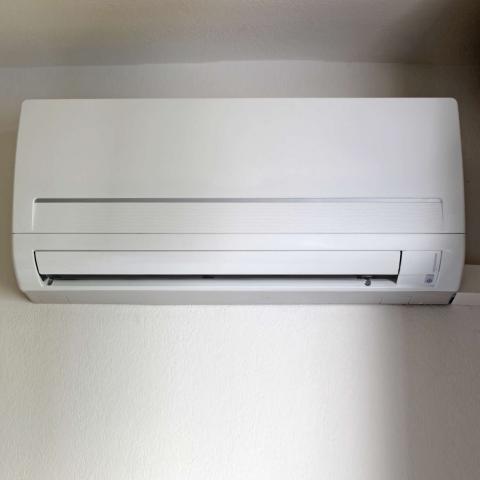
Air conditioner in Japanese is also called クーラー (kūrā), which comes from the word “cooler.”
2. Japanese Nouns: Technology
Most important Japanese nouns regarding technology originated from other countries and were imported to Japan. Expressed in Katakana, these imported words have Japanese pronunciation that resembles the original English words.
| English | Kanji | Hiragana/Katakana | Reading | |
| 9 | computer | ー | コンピューター | conpyūtā |
| 10 | laptop | ー | ノートパソコン | nōto pasokon |
| 11 | tablet | ー | タブレット | taburetto |
| 12 | cellphone | 携帯電話 | けいたいでんわ | keitai denwa |
| 13 | headphone | ー | ヘッドホン | heddohon |
| 14 | charger | 充電器 | じゅうでんき | jyūdenki |
| 15 | wifi | ー | ワイファイ | waifai |
| 16 | app | ー | アプリ | apuri |
| 17 | website | ー | ウェブサイト | webusaito |
| 18 | file | ー | ファイル | fairu |
| 19 | account | ー | アカウント | akaunto |
| 20 | password | ー | パスワード | pasuwādo |
Examples
私はタブレットよりもノートパソコンの方が好きです。Watshi wa taburetto yori mo nōto pasokon no hō ga suki desu.
I like laptops more than tablets.
ワイファイのパスワードは何ですか。
Waifai no pasuwādo wa nan desu ka.
What is the wifi password?
あなたの携帯電話の充電器を使ってもいいですか。
Anata no keitai denwa jyūdenki o tsukatte mo ii desu ka.
Can I use your mobile phone charger?
Our vocabulary list about the Top 20 Words You’ll Need for the Internet is also useful to learn Japanese nouns related to technology.
3. Japanese Nouns: Transportation
Transportation is an essential part of daily life. Some of the most useful Japanese nouns are vocabulary words related to transportation. This is especially true for those who travel in Japan, who may need to ask how to get around.
| English | Kanji | Hiragana/Katakana | Reading | |
| 21 | airplane | 飛行機 | ひこうき | hikōki |
| 22 | train | 電車 | でんしゃ | densha |
| 23 | subway | 地下鉄 | ちかてつ | chikatetsu |
| 24 | bus | – | バス | basu |
| 25 | taxi | – | タクシー | takushī |
| 26 | bicycle | 自転車 | じてんしゃ | jitensha |
| 27 | station | 駅 | えき | eki |
| 28 | bus stop | バス停 | ばすてい | basutei |
| 29 | airport | 空港 | くうこう | kūkō |
| 30 | traffic light | 信号 | しんごう | shingō |
| 31 | intersection | 交差点 | こうさてん | kōsaten |
| 32 | road | 道/道路 | みち/どうろ | michi/dōro |
Example
一番近いバス停はどこですか。Ichi-ban chikai basutei wa doko desu ka.
Where is the nearest bus stop?
私の町には地下鉄はありません。
Watashi no machi ni wa chikatetsu wa arimasen.
There is no subway in my town.
信号のある交差点を左に曲がります。
Shingō no aru kōsaten o hidari ni magarimasu.
Turn left at the intersection which has a traffic light.

Public transportation is well-developed in Japan, especially in the large cities. Shinkansen is very famous for its super-fast speed and is popular among foreign tourists.
4. Japanese Nouns: Food & Restaurants
Whenever you go out to eat at restaurants, you look at a menu and order what you want to eat and drink. Knowing Japanese nouns and vocabulary related to restaurants makes your dining-out experience much smoother. Japan has a variety of foods and a wide range of ingredients are used in the Japanese food culture. If can’t eat certain things due to your religion, an allergy, or a discipline such as vegetarianism, you have to ask a staff member if your preferred meal is available. Here’s a common Japanese nouns list to help you do so!
| English | Kanji | Hiragana/Katakana | Reading | |
| 33 | menu | ー | メニュー | menyū |
| 34 | waiter/waitress | 店員 | てんいん | ten’in |
| 35 | bill | 会計 | かいけい | kaikei |
| 36 | fork | ー | フォーク | fōku |
| 37 | knife | ー | ナイフ | naifu |
| 38 | spoon | ー | スプーン | supūn |
| 39 | chopsticks | 箸箸 | はし | hashi |
| 40 | water | 水 | みず | mizu |
| 41 | vegetables | 野菜 | やさい | yasai |
| 42 | beef | 牛肉 | ぎゅうにく | gyūniku |
| 43 | pork | 豚肉 | ぶたにく | butaniku |
| 44 | chicken | 鶏肉 | とりにく | toriniku |
Examples
ベジタリアンのメニューはありますか。Bejitarian no menyū wa arimasu ka.
Do you have a vegetarian menu?
お箸の使い方を教えてください。
O-hashi no tsukaikata o oshiete kudasai.
Please teach me how to use chopsticks.
私は豚肉を食べられません。
Watashi wa butaniku o taberaremasen.
I can’t eat pork.
For more about Japanese nouns related to food and restaurants, see our Food – Utensils & Tableware and Restaurant vocabulary lists.

Japan has great food culture where you can find tasty food from low-end and high-end restaurants.
5. Japanese Nouns: School Essentials
The Japanese school system consists of elementary school, middle school, high school, and higher education such as universities and vocational schools. Compulsory education is six years of elementary school and three years of middle school, and both are free. Here are the most common nouns in Japanese related to school.
| English | Kanji | Hiragana/Katakana | Reading | |
| 45 | elementary school | 小学校 | しょうがっこう | shōgakkō |
| 46 | middle school | 中学校 | ちゅうがっこう | shōgakkō |
| 47 | high school | 高校 | こうこう | kōkō |
| 48 | college/university | 大学 | だいがく | daigaku |
| 49 | student | 生徒/学生 | せいと/がくせい | seito/gakusei |
| 50 | teacher | 先生/教師 | せんせい/きょうし | sensei/kyōshi |
| 51 | major | 専攻 | せんこう | senkō |
| 52 | degree | 学位 | がくい | gakui |
| 53 | exam | 試験 | しけん | shiken |
| 54 | homework | 宿題 | しゅくだい | shukudai |
Examples
あなたの専攻は何ですか。Anata no senkō wa nan desu ka.
What is your major?
彼女は小学校の先生です。
Kanojo wa shōgakkō no sensei desu.
She is a teacher at an elementary school.
私は宿題を終えた後に遊びに行きます。
Watashi wa shukudai o oeta ato ni asobi ni ikimasu.
I will go and play after finishing my homework.
6. Japanese Nouns: Occupations

To engage in certain occupations, one must pass the related national examinations. The most difficult occupations to attain in Japan are said to be a doctor, lawyer, and accountant, in terms of how difficult the national examinations are.
| English | Kanji | Hiragana/Katakana | Reading | |
| 55 | doctor | 医師 | いし | ishi |
| 56 | nurse | 看護師 | かんごし | kangoshi |
| 57 | lawyer | 弁護士 | べんごし | bengoshi |
| 58 | chef | 料理人 | りょうりにん | ryōrinin |
| 59 | businessperson | 実業家 | じつぎょうか | jitsugyōka |
| 60 | police officer | 警察官 | けいさつかん | keisatsukan |
| 61 | firefighter | 消防士 | しょうぼうし | shōbōshi |
| 62 | engineer | 技術者 | ぎじゅつしゃ | gijutsusha |
| 63 | civil servant | 公務員 | こうむいん | kōmuin |
| 64 | accountant | 会計士 | かいけいし | kaikeishi |
Examples
消防士になるのは難しいですか。Shōbōshi ni naru no wa muzukashii desu ka.
Is it difficult to become a firefighter?
私は警察官になりたいです。
Watashi wa keisatsukan ni naritai desu.
I want to become a police officer.
公務員の職業は安定しているので人気です。
Kōmuin no shokugyō wa antei shite iru node ninki desu.
The occupation of civil servant is popular because it is stable.
To hear how to pronounce the words on this Japanese list of nouns, see our Jobs / Work vocabulary list.
 Some people take many years to pass the national examination to be a lawyer or accountant in Japan.
Some people take many years to pass the national examination to be a lawyer or accountant in Japan.
7. Japanese Nouns: Family Members
It’s useful to know Japanese nouns and vocabulary related to family members when you introduce yourself and describe your family to someone.
| English | Kanji | Hiragana/Katakana | Reading | |
| 65 | family | 家族 | かぞく | kazoku |
| 66 | mother | 母/お母さん | はは/おかあさん | haha/o-kā-san |
| 67 | father | 父/お父さん | ちち/おとうさん | chichi/o-tō-san |
| 68 | parent | 親 | おや | oya |
| 69 | daughter | 娘 | むすめ | musume |
| 70 | son | 息子 | むすこ | musuko |
| 71 | grandma | 祖母 | そぼ | sobo |
| 72 | grandpa | 祖父 | そふ | sofu |
Examples
私の母は看護師です。Watashi no haha wa kangoshi desu.
My mother is a nurse.
私の家族は5人家族です。
Watashi no kazoku wa go-nin kazoku desu.
My family has five family members.
彼女の息子は6歳です。
Kanojo no musuko wa roku-sai desu.
Her son is six years old.
Compared to English, Japanese has more words to describe family members according to age and style, and also uses both formal and informal forms. For more details on this, please visit our Japanese Family article and our Must-Know Terms for Family Members vocabulary list.
8. Japanese Nouns: Body Parts

Knowing the Japanese nouns for the parts of the body is very useful, especially when it comes to health (e.g. seeing a doctor at a hospital or working out at the gym).
| English | Kanji | Hiragana/Katakana | Reading | |
| 73 | body | 体 | からだ | karada |
| 74 | head | 頭 | あたま | atama |
| 75 | shoulder | 肩 | かた | kata |
| 76 | arm | 腕 | うで | ude |
| 77 | leg | 足 | あし | ashi |
| 78 | chest | 胸 | むね | mune |
| 79 | abdomen | 腹 | はら | hara |
| 80 | face | 顔 | かお | kao |
| 81 | eye | 目 | め | me |
| 82 | nose | 鼻 | はな | hana |
| 83 | mouth | 口 | くち | kuchi |
| 84 | ear | 耳 | みみ | mimi |
Examples
風邪を引いたので頭が痛いです。Kaze o hiita node atama ga itai desu.
I have a headache because I caught a cold.
体を動かす運動は健康に良いです。
Karada o ugokasu undō wa kenkō ni ii desu.
Exercise that moves your body is good for health.
彼女は可愛い大きな目を持っています。
Kanojo wa kawaii ōkina me o motte imasu.
She has cute big eyes.
For more Japanese nouns of body parts, and to check their Japanese pronunciation, visit our Body Parts vocabulary list.

Many Japanese people are keen on diet and health.
9. Japanese Nouns: Time
Expressing the time is essential for everyday life. Learning the Japanese nouns for time is always useful for things such as scheduling plans, making an appointment, or just checking the time and date. Here’s our Japanese nouns list for words related to time.
| English | Kanji | Hiragana/Katakana | Reading | |
| 85 | today | 今日 | きょう | kyō |
| 86 | yesterday | 昨日 | きのう | kinō |
| 87 | tomorrow | 明日 | あした | kinō |
| 88 | Monday | 月曜日 | げつようび | getsu-yōbi |
| 89 | Tuesday | 火曜日 | かようび | ka-yōbi |
| 90 | Wednesday | 水曜日 | すいようび | sui-yōbi |
| 91 | Thursday | 木曜日 | もくようび | moku-yōbi |
| 92 | Friday | 金曜日 | きんようび | kin-yōbi |
| 93 | Saturday | 土曜日 | どようび | do-yōbi |
| 94 | Saturday | 日曜日 | にちようび | nichi-yōbi |
| 95 | day | 日 | にち/ひ | nichi/hi |
| 96 | week | 週 | しゅう | shū |
| 97 | month | 月 | つき/げつ | tsuki/getsu |
| 98 | year (as unit) | 年 | とし/ねん | toshi/nen |
| 99 | hour | 時間 | じかん | jikan |
| 100 | minute | 分 | ふん | fun |
Examples
明日は金曜日です。Ashita wa kin-yōbi desu.
Tomorrow is Friday.
結果を出すまで2年と5ヶ月かかりました。
Kekka o dasu made ni-nen to go-kagetsu kakarimashita.
It took two years and five months to achieve the result.
私は今日3時間歩きました。
Watashi wa kyō san-jikan arukimashita.
I walked three hours today.
There are various expressions regarding dates in Japanese. Visit our article on Japanese Dates to learn more Japanese nouns of time and date, and how to use that information in real life!
10. Conclusion: How JapanesePod101 Can Help You Learn More Japanese

We’ve now introduced the 100 most useful Japanese nouns. I hope this article helps you improve your Japanese vocabulary and skills!
Did you learn any new words today? Are there any Japanese nouns you still want to know? Let us know in the comments; we look forward to hearing from you!
If you would like to learn more about the Japanese language and other Japanese nouns, you’ll find a lot more useful content on JapanesePod101.com. We provide a variety of free lessons for you to improve your Japanese language skills.
To learn about Japanese nouns and more vocabulary, check out Top 25 Japanese Nouns and Japanese Core 100 Word List. Our vocabulary lists about School, School Subjects, and Body – Describing the Body are also useful; you can learn more about the topics and practice your Japanese pronunciation with audio.
There’s so much more, too! Learn faster and enjoy studying Japanese at JapanesePod101.com!

Learn the Most Useful Compliments in Japanese
Giving compliments makes people feel important and happy, and compliments are a great way to express your positive feelings. However, “When in Rome, do as the Romans do!” There’s a particular way that people give and respond to compliments in Japanese.
Before giving compliments in Japanese, keep this in mind: Humbleness and modesty are the most important values in Japanese culture. Therefore, it’s considered bad manners to show off and explicitly exhibit your abilities and achievements. For this reason, people aren’t used to receiving a lot of praise.
However, it’s still a good thing to give a compliment when someone has great traits or has done wonderful things. Giving compliments is a useful way to improve communication and your relationships with others.
Let’s learn the most useful Japanese compliments and how to give them at JapanesePod101.com!

Table of Contents
- Complimenting Someone’s Appearance
- Complimenting Someone’s Work
- Complimenting Someone’s Skills
- How to Make Your Compliments Sound More Sincere
- What to Expect After Giving Compliments
- Conclusion: How JapanesePod101 Can Help You Learn More Japanese
1. Complimenting Someone’s Appearance
In Japanese culture, compliments aren’t given directly, contrary to compliments in other cultures (such as American). Compliments in Japanese tend to be mild, indirect, and euphemistic.
1 – Hair
Casual:
髪の毛切った?ショートヘア似合うね。かわいい (かっこいい) ね!
Kaminoke kitta? Shōto hea niau ne. Kawaii (kakkoii) ne !
“Did you cut your hair? The short hairstyle suits you well. You are cute (handsome)!”
The Japanese compliment above is in the casual style. In order to say it politely, change the predicate 述語 (Jyutsugo) to the polite honorific 丁寧語 (Teineigo).
Polite:
髪の毛切りましたか。ショートヘア似合いますね。かわいい (かっこいい) ですね!
Kaminoke kirimashita ka. Shōto hea niaimasu ne. Kawaii (kakkoii) desu ne !
2 – Outfit
Casual:
そのシャツいいね。
Sono shatsu ii ne.
Polite:
そのシャツいいですね。
Sono shatsu ii desu ne.
Meaning: “That shirt is good.” (“Your shirt looks good.” )
Casual:
そのスカート素敵だね。どこで買ったの?
Sono sukāto suteki da ne. Doko de katta no?
Polite:
そのスカート素敵ですね。どこで買いましたか。
Sono sukāto suteki desu ne. Doko de kaimashita ka.
Meaning: “That skirt is nice. (Your skirt looks nice.) Where did you buy it?”
3 – Smile
Casual:
笑顔が素敵だね /かわいいね。
Egao ga suteki da ne / kawaii ne.
Polite:
笑顔が素敵ですね /かわいいですね。
Egao ga suteki desu ne / kawaii desu ne.
Meaning: “(Your) smile is nice / pretty.”
4 – General
Casual:
彼女はとても美人だね。
Kanojo wa totemo bijin da ne.
Polite:
彼女はとても美人ですね。
Kanojo wa totemo bijin desu ne.
Meaning: “She is very beautiful.”
Casual:
彼は背が高くてハンサムだね。
Kare wa se ga takakute hansamu da ne.
Polite:
彼は背が高くてハンサムですね。
Kare wa se ga takakute hansamu desu ne.
Meaning: “He is tall and handsome.”
How to compliment a Japanese girl: Egao ga totemo kawaii ne. = “Your smile is very cute.”
2. Complimenting Someone’s Work
In Japanese business settings, people typically use the formal and honorific language. Some people use casual language toward younger subordinates, but you should never use casual language when talking to your boss, seniors, or clients, because it’s very rude and inappropriate. Following is a list of the best compliments in Japanese for the workplace.
5 – Good job! / Well done!
Casual: 良くやったな!(Yoku yatta na!)
Polite: 良くやりましたね!(Yoku yarimashita ne!)
6 – Great work! / Excellent! / Bravo!
Casual: お見事!(O-migoto!)
Polite: お見事です!(O-migoto desu!)
7 – (Your) presentation today was very good.
Casual: 今日のプレゼンとても良かったよ。(Kyō no purezen totemo yokatta yo.)
Polite: 今日のプレゼンとても良かったです。(Kyō no purezen totemo yokatta desu.)
8 – That’s a nice idea with pretty good sense.
Casual: なかなかセンスの良いアイディアだね。(Nakanaka sensu no ii aidia da ne.)
Polite: なかなかセンスの良いアイディアですね。(Nakanaka sensu no ii aidia desu ne.)
9 – You are amazing to have solved that difficult matter easily.
Casual: あの難しい案件を簡単に解決させてすごいね。(Ano muzukashii anken o kantan ni kaiketsu sasete sugoi ne.)
Polite: あの難しい案件を簡単に解決させてすごいですね。(Ano muzukashii anken o kantan ni kaiketsu sasete sugoi desu ne.)
* すごい (sugoi) is a Japanese adjective which can be translated as “great,” “amazing,” “wonderful,” “cool,” etc. This is often used when something or someone has strong abilities.
The casual phrase すごいね (Sugoi ne) and polite phrase すごいですね (Sugoi desu ne) are very useful phrases you can use in many situations. They can be used just like “Wow!” in English.
Here’s a compliment for a Japanese businessman: Kyō no purezen totemo yokatta desu. = “Presentation today was very good.”
3. Complimenting Someone’s Skills
10 – The meal is very delicious! You are good at cooking. (You are a good cook!)
Casual: ご飯がとてもおいしいよ!料理上手いね!(Gohan ga totemo oishii yo! Ryōri umai ne!)
Polite: ご飯がとてもおいしいです!料理上手いですね!(Gohan ga totemo oishii desu! Ryōri umai desu ne!)
11 – You have skills and a good sense of photography.
Casual: 写真のスキルがあって、センスもいいね。(Shashin no sukiru ga atte, sensu mo ii ne.)
Polite: 写真のスキルがあって、センスもいいですね。(Shashin no sukiru ga atte, sensu mo ii desu ne.)
12 – Your English is very fluent!
Casual: 英語がすごくペラペラだね!(Eigo ga sugoku perapera da ne!)
Polite: 英語がすごくペラペラですね!(Eigo ga sugoku perapera desu ne!)
*ペラペラ (Perapera) is a Japanese onomatopoeia which expresses a state of fluent speech.
13 – You run really fast! You could participate in the Olympic Games!
Casual: 足がすごく速いね!オリンピックに出られそうだね!(Ashi ga sugoku hayai ne! Orinpikku ni deraresō da ne!)
Polite: 足がすごく速いですね!オリンピックに出られそうですね!(Ashi ga sugoku hayai desu ne! Orinpikku ni deraresō desu ne!)
14 – You are (so) amazing that you can do anything!
Casual: 何でもできてすごいね!(Nan demo dekite sugoi ne!)
Polite: 何でもできてすごいですね!(Nan demo dekite sugoi desu ne!)
Good handwriting skills are praised in Japan as it’s considered a skill of the well-educated and sophisticated.
4. How to Make Your Compliments Sound More Sincere
Sometimes, compliments sound fake when you praise too much or only use words. Here are some tips for giving sincere Japanese compliments to avoid sounding empty.
1 – Avoid Direct and Exaggerated Expressions
As mentioned in the introduction, many Japanese people aren’t used to receiving compliments, especially when they’re very direct.
It becomes more natural and sounds real when you make a comment with euphemistic and indecisive expressions, and avoid using straightforward words.
For example:
Not Good
豪華なスカートを履いていますね。
Gōka na sukāto o haite imasu ne.
“You are wearing a gorgeous skirt.”
Good
ファッションのセンスが素敵ですね。
Fasshon no sensu ga suteki desu ne.
“Your fashion sense is nice.”
Not Good
君の瞳はとても美しいよ。
Kimi no hitomi wa totemo utsukushii yo.
“Your eyes are very beautiful.”
Good
笑顔がとても素敵だね。
Egao ga totemo suteki da ne.
“Your smile is very nice.”
2 – Don’t Praise; Tell Instead
When you compliment someone in Japanese, it sounds more natural and real when you tell them casually instead of actually praising them. The key point is to say positive things to him/her casually and naturally in the flow of conversation.
For example:
When a boy likes a girl, he shouldn’t just give her compliments one after another whenever he wants: “You are cute today, too,” “You’re so nice,” “You have a pretty hairstyle.”
However, he can give positive comments during a conversation if the situation allows for it:
At a cafe, if the girl he likes pours water to refill his glass, he can say ありがとう、優しいね (arigatō, yasashii ne.), which means “Thank you, you are kind.”
Or, when she shows him pictures of her trip, he can tell her 楽しそうだね、笑ってる顔がとてもかわいいよ(tanoshisō da ne, waratte ru kao ga totemo kawaii yo.), which means “It looks fun, your smiling face is very cute.”
3 – Refer to Someone to Add Credit
When you give compliments, refer to someone else’s comment in order to avoid direct compliments, and to add credit to make it more realistic.
For example:
田中さんは仕事ができる人だと上司が言っていました。私も本当にそう思います。
Tanaka-san wa shigoto ga dekiru hito da to jōshi ga itte imashita. Watashi mo hontō ni sō omoimasu.
“My boss said that Tanaka-san is someone who is good at his job. I really think so, too.”
みんなも言っているように、君はとても優しいね。
Minna mo itte iru yō ni, kimi wa totemo yasashii ne.
“As everyone is saying, you are very thoughtful.”
5. What to Expect After Giving Compliments
As mentioned, modesty and humbleness are important values in Japanese culture, and Japanese people aren’t used to receiving a lot of compliments or direct expressions of praise from others.
While American people usually receive compliments with confidence and pride, Japanese people often receive them with hesitance and a shy feeling. Some Japanese people may reply with negative or denial phrases to express their humbleness, rather than admitting their good ability/quality. Doing so would be considered boasting and showing pride.
Response Examples :
1.
Casual: 全然そんなことないよ (zenzen sonna koto nai yo)
Polite: 全然そんなことないです (zenzen sonna koto nai desu.)
Meaning: “(I’m) not (that) at all.”
This phrase is one of the most typical responses to compliments in Japanese. Often, compliments are met with denial, and 全然〜ない (zenzen — nai) is a common expression which means “not — at all.”
A:
ドイツ語をペラペラ話せてすごいね!
Doitsugo o perapera hanasete sugoi ne!
“You are great that you can speak German fluently!”
B:
全然すごくないよ。
Zenzen sugoku nai yo.
“I’m not great at all.”
2.
Casual: もっと上手くできたのだけど… (Motto umaku dekita no da kedo…)
Polite: もっと上手くできたのですが… (Motto umaku dekita no desu ga…)
Meaning: “I could have done better…”
This is another typical response to Japanese compliments. Saying that he or she could have done better is a way of showing modesty and that he/she needs to keep making an effort rather than satisfying the status quo.
A:
今日のプレゼンとても良かったですよ!
Kyō no purezen totemo yokatta desu yo!
“Your presentation was very good today!”
B:
そうですか?もっと上手くできたのですが…
Sō desu ka? Motto umaku dekita no desu ga…
“Was it? I could have done better…”
3.
Casual: (OOOの)足元にも及ばないよ ([OOO no] ashimoto ni mo oyobanai yo)
Polite: (OOOの)足元にも及びません ([OOO no] ashimoto ni mo oyobimasen)
Meaning: “can’t hold a candle to (OOO)” / “nowhere near as good as (OOO)”
This phrase is usually used in formal settings to respond to compliments. It literally means “I don’t even reach (someone’s) feet.” It expresses modesty by referring to someone better than you, and often, it’s the person who gave the compliment. This phrase is also used as お世辞 (O-seji), or “flattery,” to flatter a boss or client for smoother communication and relationships in traditional Japanese business customs.
Boss:
今日の商談良くやったな!君は強い交渉力を持っている。
Kyō no shōdan yoku yatta na! Kimi wa tsuyoi kōshōryoku o motte iru.
“Well done with the business today! You have a strong negotiation skill.”
Subordinate:
部長の足元にも及びません!
Buchō no ashimoto ni mo oyobimasen!
“I’m nowhere near as good as you, Director!”
For more useful phrases for business, please check out Phrases for Doing Business Successfully and Must-Know Expressions for Agreeing and Disagreeing.

The important Japanese value of modesty is reflected in phrases toward compliments.
6. Conclusion: How JapanesePod101 Can Help You Learn More Japanese
In this article, we introduced the most useful Japanese compliments and how to give/respond to compliments in Japanese. Did you find it interesting that Japanese compliments are quite a reflection of Japanese culture? Always remember not to start bragging about your skills or traits after receiving a compliment in Japan!
If you would like to learn more about the Japanese language and other useful Japanese phrases for different situations, you’ll find much more helpful content on JapanesePod101.com. We provide a variety of free lessons for you to improve your Japanese language skills.
Here’s some more information about compliments in Japanese with audio:
- Top 10 Compliments You Always Want to Hear in Japanese
- Making a Compliment
- Top 15 Compliments You Always Want to Hear
Together with compliments, learn the Top 20 Words for Positive Emotions!
And that’s not all! Learn faster and enjoy studying Japanese at JapanesePod101.com!
Before you go, let us know in the comments if there are any Japanese compliments you still want to know! We’d be glad to help, and look forward to hearing from you!

Getting Angry in Japanese: 20+ Useful Japanese Angry Phrases
It’s essential to be able to express your feelings when communicating with others in everyday life. Knowing how to express your emotions in Japanese, including anger, will help you have smoother communication with Japanese people. Although showing anger with swear words isn’t common in Japanese culture, there are various angry phrases in Japanese you can use.
Knowing angry phrases, and how to show that you’re angry in Japanese, will not only help you understand Japanese anime and Japanese TV shows better, but it will also improve your conversation and communication skills.
In this article, we’ll introduce useful angry Japanese expressions and phrases to help you discuss your emotions. Let’s learn various expressions here at JapanesePod101!

Table of Contents
- Angry Imperatives
- Angry Warnings
- Angry Blames
- Describing How You Feel
- Phrases to Calm Someone Down
- Conclusion: How JapanesePod101 Can Help You Learn More Japanese
1. Angry Imperatives
The following phrases are commonly used phrases in the imperative form for expressing anger in Japanese.
1 – Shut up.
- 黙れ (damare) — impolite, order form
- うるさい (urusai) — literally means “noisy”
Damare is a very hostile and impolite expression. You probably won’t hear this in daily conversations, but maybe in Japanese anime, especially those that are adventurous or involve lots of battles. Urusai is very casual and it’s a soft way to express “Shut up.”
Example
A: またアイス食べてるの?太るよ。
A: Mata aisu tabete ru no? Futoru yo.
A: “Are you eating ice cream again? You’ll get fat.”
B: うるさいな、ほっといて!
B: Urusai na, hottoite !
B: “Shut up, leave me alone!”
2 – Stop it.
- やめて (yamete) — casual
- やめなさい (yamenasai) — polite, order form
- やめろ (yamero) — impolite, order form
Yamete is a very casual and commonly used expression. Yamenasai is polite and usually said by a person in a superior position toward a person(s) in a lower position. Yamero is a very casual and impolite way to express “Stop it.”
Example
Mari:
やめて!ママ、お兄ちゃんがぶった!
Yamete! Mama, o-nii-chan ga butta!
“Stop it! Mom, my (big) brother hit me!”
Takashi:
マリが先に僕を押してきたんだ!
Mari ga saki ni boku o oshite kita n da!
“Mari pushed me first!”
Mom:
2人ともやめなさい!
Futari tomo yamenasai!
“Both of you, stop it!”
“Stop it, I don’t wanna hear it. ” = Yamete, kikitakunai.
3 – Cut it out.
- やめて (yamete) — casual
- いい加減にして (iikagen ni shite) — casual
Iikagen ni shite is a very useful expression which literally means “Be in good moderation.” It can be translated as “That’s enough,” “Cut it out,” and “Stop it.”
Example
いい加減にして!今すぐやめないと警察を呼ぶよ!
Iikagen ni shite ! Ima sugu yamenai to keisatsu o yobu yo!
“Cut it out! I will call the police if you don’t stop now!”
4 – Leave me alone.
- ほっといてよ (Hottoite yo)
Hottoite yo is a casual expression that’s typically used between people who are in a close relationship, such as family members and close friends.
Example
もう子供じゃないんだから、ほっといてよ!
Mō kodomo ja nai n da kara, hottoite yo!
“I’m not a child anymore, leave me alone!”
“I’m not a kid anymore, leave me alone!” = Mō kodomo ja nai n da kara, hottoite yo!
5 – Get lost.
- 失せろ (usero) — impolite, order form
You’re likely to hear this expression in Japanese anime and movies. Usero is a very impolite and hostile expression which you’ll probably hear used by a very angry Japanese man or yakuza in a movie.
Example
失せろ!2度と姿を現わすな!
Usero! Ni-do to sugata o arawasu na!
“Get lost! Never show up again!”
2. Angry Warnings
Use these angry Japanese phrases to let someone know they’re going too far and it’s time to back off!
1 – Don’t mess with me.
- 私に関わらないで (watashi ni kakawaranaide) — casual
- 俺に関わるな (ore ni kakawaru na) — masculine
Watashi ni kakawaranaide is milder and a bit more feminine, while ore ni kakawaru na is a stronger, masculine expression. They both have the connotation of “Don’t get involved with me.”
There are various Japanese personal pronouns. Watashi is for the unisex “I” in the formal style, but it sounds more feminine in the informal style. Ore is commonly used by men in very casual situations.
Example
私に関わらないで。さもないと、大変な目にあうよ。
Watashi ni kakawaranaide. Samonaito, taihen na me ni au yo.
“Don’t mess with me, or you’ll have a hard time.”
2 – You’re asking for trouble.
- 面倒 / 厄介なことになるよ (mendō / yakkai na koto ni naru yo)
This is a very useful phrase that you can use in many different situations. If you want to say it in a polite way, change the last word to narimasu yo.
Example
そんなことしたら、面倒なことになるよ。
Sonna koto shitara, mendō na koto ni naru yo.
“You’re asking for trouble if you do so.”
3 – Don’t make me say it again.
- 同じことを何度も言わせないで (onaji koto o nan-do mo iwasenaide)
This is another very common phrase you can use in many situations. If you want to say it in a polite way, add the word ください (kudasai) to the end.
Example
片付けをして!同じことを何度も言わせないで。
Katazuke o shite! Onaji koto o nan-do mo iwasenaide.
“Clean up! Don’t make me say it again.”
4 – This is my last warning.
- これが最後の警告だ (kore ga saigo no keikoku da)
You’re likely to hear this Japanese angry phrase in TV shows or movies. If you want to say it in a polite way, change the word だ (da) at the end to です (desu).
Example
これが最後の警告です。次は訴えます。
Kore ga saigo no keikoku desu. Tsugi wa uttaemasu.
“This is my last warning, I will sue you next time.”
5 – I can’t tolerate anymore.
- もう我慢できない (mō gaman dekinai)
- もう耐えられない (mō taerarenai)
These are commonly used angry Japanese sayings when someone can’t stand something anymore. If you want to say it in a polite way, conjugate the negative form ない (nai) to the polite ません (masen).
Example
もう我慢できない!今すぐそのうるさい音楽を止めろ!
Mō gaman dekinai! Ima sugu sono urusai ongaku o tomero!
“I can’t stand anymore! Stop that loud music right away!”
“I can’t tolerate this person anymore !” = Kono hito ni wa mō taerare nai!
6 – Watch your mouth.
- 言葉に気をつけろ (kotoba ni ki o tsukero) — order form
This rough phrase is commonly used by angry Japanese people in TV shows and movies. If you want to say it in a milder way, change the word つけろ (tsukero) to つけなさい (tsukenasai), or even more politely, つけてください (tsukete kudasai).
Example
親に向かってその口の聞き方はなんだ!言葉に気をつけなさい!
Oya ni mukatte sono kuchi no kikikata wa nan da! Kotoba ni ki o tsukenasai!
“Don’t you dare talk to your parent like that! Watch your mouth!”
3. Angry Blames
1 – Who do you think you are?
- 何様のつもり?(nani-sama no tsumori?) — casual
This is a casual phrase that you can use with people you’re close to, such as family or friends. When you want to imply a stronger meaning, add お前 (omae), a rude form of “you,” in front of the phrase.
Example
私に全部家事をやらせて、あなた何様のつもり?私は家政婦じゃないのよ!
Watashi ni zenbu kaji o yarasete, anata nani-sama no tsumori? Watashi wa kaseifu ja nai no yo!
“Who do you think you are to make me do all the house chores? I’m not a housemaid!”
2 – Are you out of your mind?
- 頭おかしいんじゃないの?(atama okashii n ja nai no?) — casual
- 正気ですか (shōki desu ka) — polite
Atama okashii n ja nai no? is a casual phrase that’s used among close friends or family members, while shōki desu ka is a more polite expression that can be used in workplaces.
Example
何でこうしたの?頭おかしんじゃないの?
Nande kō shita no? Atama okashii n ja nai no?
“Why did you do this? Are you out of your mind?”
“How could you say that? Who do you think you are?” = Yokumo sonna koto ieta wa ne, nani-sama no tsumori?
3 – What’s wrong with you?
- あなた一体どうしたの?(anata ittai dō shita no?)
This casual phrase is used to express frustration at someone’s unreasonable behavior.
Example
今すぐやめて!あなた一体どうしたのよ!
Ima sugu yamete! Anata ittai dō shita no yo!
“Stop it right now! What’s wrong with you?”
4 – Listen to me.
- ちゃんと聞いて (chanto kiite) — casual
- ちゃんと聞きなさい (chanto kikinasai) — polite
Chanto kiite is a casual phrase that’s used among family and friends, while chanto kikinasai is the polite and imperative form which is usually used by a superior/senior person to a junior person.
Example
言い訳をやめてちゃんと聞きなさい!
Iiwake o yamete chanto kikinasai !
“Stop making excuses and listen to me!”
5 – It’s your fault.
- あなたのせいだ (anata no sei da)
This phrase is casual and commonly used. When お前 (Omae) is used instead of あなた (anata), it becomes an even stronger expression. This is because お前 (Omae) is a rude way of saying “you.”
Example
全部あなたのせいです。責任とってください。
Zenbu anata no sei desu. Sekinin totte kudasai.
“It’s all your fault. Take responsibility for it.”
6 – It’s none of your business.
- あなたに関係ない (anata ni kankei nai)
This phrase is casual and commonly used. In order to say it more politely, use ありません (arimasen) instead of ない (nai).
Example
これは私的なことで、あなたに関係ありません。
Kore wa shiteki na koto de, anata ni kankei arimasen.
“This is a private matter and none of your business.”
4. Describing How You Feel
Now that you’ve learned how to get angry in Japanese, let’s take a look at how to describe your emotions or why you’re angry.
1 – It’s getting on my nerves.
- イライラする (iraira suru) — casual
This is a casual phrase that’s commonly used. Especially among younger people, 超ムカつく (chō mukatsuku) is also frequently used, and is considered 若者言葉 (youngster language).
Example
彼のそのような態度にイライラする。
Kare no sono yō na taido ni iraira suru.
“His attitude gets on my nerves.”
2 – I’m fed up with it.
- うんざりだ (unzari da)
This phrase is casual and very common to use. By adding する (suru), meaning “do,” or its conjugated form next to うんざり (unzari), you can also use it as a verb.
Example
彼女の言い訳にうんざりします。
Kanojo no iiwake ni unzari shimasu.
“I’m fed up with her excuses.”
3 – I hate it.
- 嫌だ (iya da)
This is a casual phrase that’s frequently used to express one’s discomfort. To say it more politely, use です(desu) instead of だ (da).
Example
嫌だ!歯医者に行きたくない!
Iya da! Haisha ni ikitakunai!
“I hate it! I don’t want to go to the dentist!”
“I hate it! I wanna quit! ” = Iya da! Mō yametai!
4 – I’m disappointed.
- がっかりだ (gagari da) — casual
- 失望しました (shitsubō shimashita) — polite
がっかりだ (gagari da) is the casual phrase, while 失望しました (shitsubō shimashita) is a more polite form that can be used in formal situations.
Example
彼のプレゼンのひどい内容に失望しました。
Kare no purezen no hidoi naiyō ni shitsubō shimashita.
“I’m disappointed with the terrible content of his presentation.”
5. Phrases to Calm Someone Down
1 – Take a deep breath.
- 深呼吸して (shinkokyū shite) — casual
深呼吸 (shinkokyū) is “a deep breath” and して (shite) is the conjugated form of する (suru), meaning “do.” If you want to say it more politely, add the word ください (kudasai) at the end.
Example
頭にきたら、深呼吸して10秒数えてください。
Atama ni kitara, shinkokyū shite jū-byō kazoete kudasai.
“When you get angry, take a deep breath and count ten seconds.”
2 – Calm down.
- 落ち着いて (ochitsuite)
This is a conjugated form of 落ち着く (ochitsuku), which means “relax.” If you want to say it more politely, add the word ください (kudasai) at the end.
Example
騒がず落ち着いてください。
Sawagazu ochitsuite kudasai.
“Please don’t make a fuss and calm down.”
“Let’s take a deep breath and calm down.” = Shinkokyū shite ochitsukimashō.
3 – Write it down.
- 書き出して (kakidashite)
The word 書き出して (kakidashite) consists of 書く (kaku), meaning “write,” and 出す (dasu), meaning “out.” If you want to say it more politely, add the word ください (kudasai) at the end.
In Japanese culture, 写経 (Shakyō) (Sutra copying and writing) of Buddhism is considered the action of calming one’s mind by concentrating only on writing, without thinking about anything else. This is done to empty one’s mind.
Example
ケンカの時は大声を出す前に、紙に嫌なことを書き出して。
Kenka no toki wa ōgoe o dasu mae ni, kami ni iya na koto o kakidashite.
“When quarreling, write down the things you don’t like on paper before yelling.”
4 – Think from a different point of view.
- 違う観点から考えて (chigau kanten kara kangaete)
It’s always good to try to see things from different angles; this also changes the way you think about things.
Example
こんな時は、違う観点から考えてみよう。
Kona toki wa, chigau kanten kara kangaete miyō.
“Let’s think from a different point of view at times like this.”
For more angry phrases in Japanese, and to hear Japanese pronunciation, see
Phrases to Use When You’re Angry.
6. Conclusion: How JapanesePod101 Can Help You Learn More Japanese
In this article, we introduced 20+ useful angry phrases in Japanese. Although Japanese people don’t often show angry emotions expressly, it’s helpful to know some angry phrases in Japanese for better understanding and communication.
Do you feel ready to express your anger in Japanese now? Let us know in the comments!
If you would like to learn more about the Japanese language and other useful Japanese phrases for different situations, you’ll find much more helpful content on JapanesePod101.com. We provide a variety of free lessons for you to help you improve your Japanese language skills. For example, here’s some more information about expressing emotions in Japanese, with audio:
- Learn the Top 20 Words for Positive Emotions
- Learn the Top 21 Words for Negative Emotions
- Phrases to Express Your Fears
- Words and Phrases to Help You Describe Your Feelings
To learn how to hold conversations in Japanese, check out Top 15 Questions You Should Know for Conversations and Top 10 Conversational Phrases.
And there’s much more! Learn Japanese faster and enjoy studying the language and culture at JapanesePod101.com!

Life Event Messages: Happy Birthday in Japanese & More
Giving proper greetings and celebration messages is essential in making relationships better. Whether you have Japanese friends online, live in Japan, or just want to understand Japanese culture, it’s good to know how Japanese people celebrate events and what they say. Once you learn how to say Happy Birthday in Japanese, Happy New Year in Japanese, and Merry Christmas in Japanese, use them practically with your friends!
Japan has various life and annual events to celebrate. Some of them come from the Western culture, such as Christmas and Valentine’s Day. But there are unique Japanese traditions as well, such as the twentieth and sixtieth birthdays, also called 成人 (Seijin) and 還暦 (Kanreki) respectively.
So, how do you wish someone well in Japanese? In this article, we introduce practical life event messages. Let’s master holiday greetings in Japanese, and more, here at JapanesePod101!

Table of Contents
- Birthday + Turning 20 Years Old
- Japanese Congratulations: Graduation
- Japanese Congratulations: New Job / Promotion
- Retirement + Turning 60 Years Old
- Japanese Congratulations: Wedding & Marriage
- Japanese Congratulations: Pregnancy and Birth
- Bad News
- Injured/Sick
- Death/Funerals: Offering Condolences in Japanese Culture
- Holidays
- Conclusion: How JapanesePod101 Can Help You Learn More Japanese
1. Birthday + Turning 20 Years Old
As is the case in other cultures, birthdays are a happy celebration in Japan. Japanese people celebrate one’s birthday with a cake with candles, and by singing the Happy Birthday to You song in English (Japanese people also sing this song in English because it’s very easy and simple). In most cases, people have a birthday party, and friends and family give gifts to the birthday person.
A person’s twentieth birthday is very important in Japanese culture, because this is the official age of maturity, called 成人 (Seijin) in Japan, and one is officially recognized as an adult. Apart from individual twentieth birthday celebrations, Japan has the national holiday 成人の日 (Seijin no Hi), or “Coming of Age Day,” on the second Monday of January every year.
Check out our Coming of Age Day page for related Japanese vocabulary.
Here are phrases to say Happy Birthday in Japanese.
1- Happy birthday!
Japanese: (お) 誕生日おめでとう!
Pronunciation: (O)tanjōbi omedetō!
It literally translates to “birthday (tanjōbi) congratulations (omedetō).” It sounds more polite when you put お (O) in front of tanjōbi.
When you want to say it during a formal occasion, or to an older person, add ございます (gozaimasu) to the end, which makes it even more polite.
2- Belated happy birthday!
Japanese: 遅くなったけど、(お)誕生日おめでとう!
Pronunciation: Osoku natta kedo, (o)tanjōbi omedetō!
You can still wish your friends a happy birthday, even if you weren’t able to do so on the actual day!
Osoku natta kedo means “It’s late, but…” To make it more polite and formal, say Osoku narimashita kedo.
3- Wish you enjoy a special day!
Japanese: 特別な日を楽しんでね!
Pronunciation: Tokubetsu na hi o tanoshinde ne!
A birthday is a special day, and when you want the birthday girl/boy to enjoy it, you can tell her/him this phrase.
To say it politely in a formal way, change ね (ne) to ください (kudasai).
It’s common to sing Happy Birthday to You in Japan.
2. Japanese Congratulations: Graduation
Whether it’s a kindergarten or university, completing school is worth a happy celebration. Japanese schools have both entrance and graduation ceremonies at the schools, which family members also attend.
Graduation from a university is often a big celebration, especially for the graduate’s parents who get to experience the fulfilling feeling of having finished raising their child. Graduates also celebrate with friends for their achievements and the good memories they made together.
Here are phrases for celebrating graduation.
1- Congratulations for your graduation!
Japanese: 卒業おめでとう!
Pronunciation: Sotsugyō omedetō!
It literally translates to “graduation (sotsugyō) congratulations (omedetō).” For formal occasions, such as when a school principal is addressing students, add ございます (gozaimasu) to the end. This makes it polite and respectful.
2- Well done for striving for four years!
Japanese: 大変な4年間よく頑張ったね!
Pronunciation: Taihen na yo-nenkan yoku ganbatta ne!
You can say this phrase to family members or friends. When you just want to say “well done,” it’s yoku ganbatta ne.
3- Lead your way step by step to make your dream come true.
Japanese: 夢に向かって一歩一歩進んでください。
Pronunciation: Yume ni mukatte ippo ippo susunde kudasai.
This phrase is often used by parents or seniors to a new graduate to encourage his/her new path in life.
It literally means “toward a dream (yume ni mukatte),” “step by step (ippo ippo),” and “go forward (susunde kudasai),” in a polite way.
Graduation of Japanese schools is in March.
3. Japanese Congratulations: New Job / Promotion
When a new university graduate gets a new job, family and friends celebrate him/her, usually by going out for a nice dinner. Some parents give a gift that will be useful for their work, such as a watch or a set of suits. In return, the child takes his or her parents out for a nice dinner once he/she gets their first salary.
When someone has a job promotion, family, friends, and sometimes his/her boss and team, celebrate him/her. It doesn’t necessarily involve giving a gift, but people go out for a drink or dinner, in most cases.
Here are phrases to celebrate getting a new job/promotion in Japanese.
1- Congratulations for your new job / promotion!
Japanese: 就職 / 昇進おめでとう!
Pronunciation: Shūshoku / Shōshin omedetō!
It literally translates to “employment (shūshoku) / promotion (shōshin),” and “congratulations (omedetō).” You can use this phrase to congratulate your friends, family, and younger colleagues.
In Japan, the start of work for newly employed graduates is usually in April.
2- Good luck in your new workplace.
Japanese: 新しい職場で頑張ってね。
Pronunciation: Atarashī shokuba de ganbatte ne.
This is a very useful phrase to use when your friend or family member gets a new job.
It breaks down to “at new workplace (atarashii shokuba de),” and “strive well (ganbatte ne).” If you want to say it more politely for a formal setting, change ね (ne) to ください (kudasai).
3- I’m looking forward to your success.
Japanese: あなたの活躍を楽しみにしています。
Pronunciation: Anata no katsuyaku o tanoshimi ni shite imasu.
This is a polite phrase that a family member or boss/elder colleague can tell someone who gets a new job or a promotion. It breaks down to “your success (anata no katsuyaku),” and “I’m looking forward to (tanoshimi ni shite imasu).”
4. Retirement + Turning 60 Years Old
Traditionally, the age of retirement in Japan is sixty. In the traditional Japanese employment system, called 終身雇用 (Shūshin koyō), or “life-time employment,” retirement means that someone has finished working by serving a company for some decades. It’s considered honorable and respectable.
Not only family, but also his/her company and colleagues, often have a celebration party with flowers and gifts. Nowadays, due to an increase in the aging population, active and healthy seniors continue to work after they turn sixty years old, sometimes until their sixty-fifth of seventieth birthday.
On the other hand, turning sixty years old is considered good fortune and a cause to celebrate; this celebration is called 還暦 (Kanreki). Following the traditional sixty-year calendar cycle of the lunar calendar, turning sixty means accomplishing its cycle. Thus, it’s the beginning of another cycle in his/her life. The person’s family celebrates him/her by giving gifts in red, which is the color of fortune.
Below are phrases to celebrate retirement/sixtieth birthdays in Japanese.
1- Congratulations for your retirement!
Japanese: 定年退職おめでとう!
Pronunciation: Teinen taishoku omedetō!
This is a very common phrase of congratulations. It literally translates to “retirement age resignation (teinen taishoku) congratulations (omedetō).”
When you want to say it for a formal occasion, add ございます (gozaimasu) to the end; this makes it even more polite.
2- Well done for 30 years of contribution.
Japanese: 30年間の献身お疲れ様でした。
Pronunciation: San-jū-nenkan no kenshin otsukare-sama deshita.
お疲れ様 (Otsukare-sama) is one of the most common Japanese untranslatable words. It has various meanings, depending on the situation. But in this case, it means “Well done.”
3- Please enjoy your new stage of life.
Japanese: 次の新しい人生を楽しんでください。
Pronunciation: Tsugi no atarashii jinsei o tanoshinde kudasai.
Retired people often spend plenty of their new free time for hobbies and enjoyment. This polite phrase is useful when you wish for someone to have a nice life after retirement.
5. Japanese Congratulations: Wedding & Marriage
The average age of a person’s first marriage nowadays is older (around thirty) than it was some decades ago; people’s views on marriage are becoming more diverse and flexible, as well. However, getting married and having a wedding is still a big life event in Japan.
Japanese marriage traditions typically include the following:
- 結納 (yuinō), or “engagement ceremony”
- 入籍 (nyūseki), or “official marriage register”
- 挙式 (kyoshiki), or “wedding ceremony”
- 披露宴 (hirōen), or “wedding party”
The western style of wedding ceremonies is becoming very popular in Japan, although there are some people who prefer the traditional Japanese style with the 着物 (kimono).
So, how do you congratulate a wedding in Japanese? Below are phrases for celebrating marriage in Japanese.
1- Congratulations for your marriage!
Japanese: 結婚おめでとう!
Pronunciation: Kekkon omedetō!
This is a very common phrase for congratulations in Japanese when someone is getting married. It literally translates to “marriage (kekkon) congratulations (omedetō).”
When you want to say it in a formal occasion, add ございます (gozaimasu) to the end; this makes it even more polite.
2- I wish you happiness for many years to come.
Japanese: 末長くお幸せに。
Pronunciation: Suenagaku o-shiawase ni.
It literally translates to “for a long time (suenagaku), be happy (o-shiawase ni).” This phrase is also commonly used together with Kekkon omedetō.
3- Have a wonderful married life.
Japanese: 素敵な結婚生活を送ってね。
Pronunciation: Suteki na kekkon seikatsu o okutte ne.
This is another common message for a newly married couple. When you want to say it in a formal occasion, change ね (ne) to ください (kudasai).
Japanese weddings are conducted in either the western style or the Japanese traditional style.
6. Japanese Congratulations: Pregnancy and Birth
Pregnancy and birth are auspicious events in someone’s life. Traditionally, people give congratulation messages when a pregnant woman announces her pregnancy, and send her gifts after the baby is born. Japanese culture doesn’t have a “baby shower” celebration traditionally; however, the baby shower is becoming popular among young people due to the influence of western culture.
Below are phrases to celebrate pregnancy/birth in Japanese.
1- Congratulations for your pregnancy!
Japanese: 妊娠おめでとう!
Pronunciation: Ninshin omedetō!
For a formal occasion, change 妊娠 (ninshin), meaning “pregnancy,” to ご懐妊 (go-kainin), which is a more respectful form of the word “pregnancy,” and add ございます (gozaimasu) to the end to make it more polite and respectful. However, this form is very formal and not commonly used.
2- I wish a healthy baby will be born.
Japanese: 元気な赤ちゃんが生まれますように。
Pronunciation: Genki na aka-chan ga umaremasu yō ni.
It literally means “lively baby (genki na aka-chan), be born (umaremasu)” + expression of wish (yō ni).
This phrase is also commonly used together with Ninshin omedetō.
3- Congratulations for a baby’s birth!
Japanese: 赤ちゃんの誕生おめでとう!
Pronunciation: Aka-chan no tanjō omedetō!
Tell this message when your friend has their baby. For a formal occasion, add ございます (gozaimasu) to the end; this makes it more polite and respectful.
7. Bad News
Life isn’t always full of happy events and celebrations, and sometimes bad things can happen in our lives. In Japanese culture, it’s very important to have empathy and give consideration to other people’s feelings. This is because the culture puts values on 和 (Wa), or harmony in our society.
When someone tells you bad news, it’s good to listen carefully first, show that you understand him/her, and then say something to cheer him/her up.
Here are some Japanese condolences messages that you can say to those who have bad news.
1- I’m sorry to hear that.
Japanese: それは残念です。
Pronunciation: Sore wa zannen desu.
It literally translates to “it is regrettable (sore wa zannen)” + polite way to finish a sentence (desu).
Say this to your colleague, for example, if he confides in you that he couldn’t pass a promotion exam, or his pet has passed away.
2- I understand your feelings.
Japanese: あなたのお気持ち分かります。
Pronunciation: Anata no o-kimochi wakarimasu.
It literally translates to “your feeling [polite] (anata no o-kimochi), I understand (wakarimasu).” This is a typical message to show that you understand him/her and that you’re with him/her.
3- Cheer up!
Japanese: 元気出して!
Pronunciation: Genki dashite!
This is a very straightforward phrase to cheer someone up. Say this phrase to your friends or someone who has a close relationship with you.
8. Injured/Sick
An unexpected injury or sickness can happen anytime and to anyone. Whether it happened to your grandparent, friend, or colleague, it’s always nice to offer him or her some warm messages.
Here are some useful phrases you can say to those who get injured/sick.
1- How are you feeling?
Japanese: 気分はどうですか。
Pronunciation: Kibun wa dō desu ka.
This is a typical question you can ask when someone falls ill. If it’s a family member or someone very close to you, you can also say kibun wa dō? in a casual manner. Japanese people often make おかゆ (O-kayu), or “rice porridge,” for a sick person as an easy-to-digest and stomach-friendly meal.
2- I hope you get well soon.
Japanese: 早く良くなりますように。
Pronunciation: Hayaku yoku narimasu yō ni.
This is a very common and important phrase that you can tell any injured or sick person.
3- Please take care.
Japanese: お大事に。
Pronunciation: O-daiji ni.
This is another very important phrase you should tell an injured/sick person. This is usually said at the end of a conversation before you leave.
For a more polite form, add なさってください (nasatte kudasai) when speaking to someone elderly or respectable.
Healthcare in Japan provides universal-care based on the national health insurance program.
9. Death/Funerals: Offering Condolences in Japanese Culture
While a newborn life is blessed and celebrated, any life is destined to experience death sooner or later. Death is considered a serious matter, and a funeral is usually held solemnly. Even if it happened to a person who is very close, Japanese people use formal and respectful language for messages to the deceased’s family and relatives.
Below are condolence phrases in Japanese that you can use.
1- Please accept my sincere condolences.
Japanese: お悔やみ申し上げます。
Pronunciation: O-kuyami mōshiagemasu.
This phrase is formal and commonly used to show your condolences, usually at a funeral. It literally translates to “condolence (o-kuyami), [I] say (mōshiagemasu).” Note that the last word here is the most respectful and humble expression for the word “say.”
2- I pray that his/her soul may rest in peace.
Japanese: ご冥福をお祈りいたします。
Pronunciation: Go-meifuku o oinori itashimasu.
This phrase is formal and very commonly used. It literally translates to “happiness in the next world (go-meifuku), [I] pray (oinori), do (itashimasu).” Note that the last word here is a humble expression.
3- I’m so sorry, I don’t know what to say.
Japanese: 御愁傷様です。なんと言っていいかわかりません。
Pronunciation: Go-shūshō-sama desu. Nan to itte ii no ka wakarimasen.
You can use this polite phrase when someone tells you that someone you know has passed away. Go-shūshō-sama refers to a thing or status that people lament and grieve.
10. Holidays
Do you know whether Japanese people celebrate Christmas in Japan? Yes, they do! However, most Japanese people don’t have any religious feeling for Christmas celebrations; it’s rather regarded as a special and romantic event for couples, or as a happy event for friends and family to eat cakes and give gifts. Christmas Day isn’t a national holiday in Japan.
On the other hand, お正月 (o-shōgatsu), or New Year’s Day, is a traditional annual festive holiday. It’s one of the most important events of the year, and family and relatives get together and celebrate the coming new year. January 1 is the actual holiday, and many companies are off from the end of the year until the first few days of January.
Here are phrases for holiday greetings in Japanese, including how to say Merry Christmas in Japanese and Japanese New Year congratulations!
1- Merry Christmas!
Japanese: メリークリスマス!
Pronunciation: Merī kurisumasu!
How to say Merry Christmas in Japanese is almost the same as in English. It’s directly imported in Japanese, but Japanese people pronounce it in the Japanese way. Also, it’s written merī kurisumasu.
Check out Must-Know Christmas Day Vocabulary for more Christmas-related terms in Japanese.
2- Happy New Year!
Japanese: 明けましておめでとう!
Pronunciation: Akemashite omedetō
“Happy New Year” in Japanese is akemashite omedetō, which literally means “(a new year day has) dawned (明けまして), congratulations (omedetō).” This is the most-used phrase for “happy holidays” in Japanese for the new year.
When you want to say it in a formal occasion or to an older person, add ございます (gozaimasu) to the end; this makes it even more polite.
3- To another good year!
Japanese: 今年もよろしく!
Pronunciation: Kotoshi mo yorosiku!
This phrase is very popular among friends, colleagues, and clients.
Kotoshi mo means “this year, too” and yoroshiku is another one of the most common Japanese untranslatable words. It has various meanings depending on the situation, but in this case, it means “best regards” or “favorably please.”
For more useful holiday greetings in Japanese, check out Holiday Greetings and Wishes for the Holiday Season and Happy New Year! Words & Phrases for the New Year! You’ll learn Japanese winter seasonal greetings and customs.
おせち (osechi) is a special meal for the New Year in Japan, and we eat it with best wishes phrases in Japanese.
11. Conclusion: How JapanesePod101 Can Help You Learn More Japanese
We introduced Japanese life event messages, such as how to say Happy Birthday in Japanese and Merry Christmas in Japanese. I hope this article was useful in improving your Japanese for better communication with your friends!
If you would like to learn more about the Japanese language and holiday greetings in Japanese, you’ll find much more useful content on JapanesePod101.com. We provide a variety of free lessons for you to improve your Japanese language skills.
For more about Japanese holidays and Japanese holiday vocabulary, check out Holidays in Japan. To learn about how to express your feelings, you’ll find Words and Phrases to Help You Describe Your Feelings useful; you can even learn and practice your pronunciation with audio. And for conversation practice, Top 15 Questions You Should Know for Conversations and Top 10 Conversational Phrases are very helpful!
Know that your hard work will pay off; with enough practice, you’ll be speaking like a native in no time with JapanesePod101.com!
Before you go, let us know which of these phrases you’ll be able to use first! Are there any life event messages you still want us to cover? Let us know in the comments!

Learn the Top 100 Essential Japanese Adjectives
Do you realize how many adjectives you use when you describe or express something, such as feeling, personality, weather conditions, and the size and color of things? Adjectives in Japanese are various and rich in expression, so learning the top 100 Japanese adjectives will greatly improve your conversation skills in Japanese!
It’s not very difficult to learn Japanese adjectives rules, as they work in mostly the same way as they do in English grammar. Before we move onto our list, though, it’s prudent to go over Japanese adjectives rules to give you context.
So first things first: Where do Japanese adjectives go?
For example, a Japanese adjective is placed before a noun: 親切な人 (shinsetsu na hito), meaning “kind person.” Or they can follow the noun + be verb + adjective pattern: 外は寒い (soto wa samui), meaning “outside is cold.”
Most Japanese adjectives end with the sound of either Hiragana い (i) or な (na), unless it’s not in past form. An adjective consists of a stem, such as 親切 (shinsetsu), which never changes, and a suffix, such as な (na), which can change.
Ready to expand your Japanese adjectives vocabulary? You’ll enjoy speaking Japanese a lot more once you know the variety of Japanese adjectives! Here’s our top 100 Japanese adjectives list at JapanesePod101.com!

Table of Contents
- Describing Dimension, Size, Distance & Number
- Describing Value
- Describing Sense
- Japanese Adjectives for Personality & Feelings
- Describing Speed, Difficulty, Importance, etc.
- Describing Colors
- Describing Shapes
- Describing Weather
- Japanese Adjectives for Food: Describing Taste
- Describing Situations
- Describing Physical Traits or Physical Conditions
- Describing Appearance and Condition
- Conclusion: How JapanesePod101 Can Help You Learn More Japanese
1. Describing Dimension, Size, Distance & Number
1- Vocabulary
| Reading | Kanji | Hiragana | English | |
|---|---|---|---|---|
| 1 | ōkii | 大きい | おおきい | big |
| 2 | chiisai | 小さい | ちいさい | small |
| 3 | hiroi | 広い | ひろい | wide |
| 4 | semai | 狭い | せまい | narrow |
| 5 | takai | 高い | たかい | tall |
| 6 | hikui | 低い | ひくい | short; low |
| 7 | omoi | 重い | おもい | heavy |
| 8 | karui | 軽い | かるい | light |
| 9 | chikai | 近い | ちかい | close |
| 10 | tōi | 遠い | とおい | far |
| 11 | ōi | 多い | おおい | many |
| 12 | sukunai | 少ない | すくない | few |
2- Example Sentences
- 部屋に大きいベッドと小さい椅子があります。
Heya ni ōkii beddo to chiisai isu ga arimasu.
There is a big bed and a small chair in the room. - このカバンは重いです。
Kono kaban wa omoi desu.
This bag is heavy. - 駅はここから遠いです。
Eki wa koko kara tōi desu.
The station is far from here. - あそこに高いビルがあります。
Asoko ni takai biru ga arimasu.
There is a tall building there.
2. Describing Value
1- Vocabulary
| Reading | Kanji | Hiragana | English | |
|---|---|---|---|---|
| 13 | yoi | 良い | よい | good |
| 14 | warui | 悪い | わるい | bad |
| 15 | subarashii | 素晴らしい | すばらしい | great |
| 16 | hidoi | ひどい | ひどい | awful; terrible |
| 17 | utsukushii | 美しい | うつくしい | beautiful |
| 18 | minikui | 醜い | みにくい | ugly |
| 19 | kōka na | 高価な | こうかな | expensive |
| 20 | yasui | 安い | やすい | cheap |
2- Example Sentences
- 私はテストで良い結果を出した。
Watashi wa tesuto de yoi kekka wo dashita.
I got a good result on the test. - そこから素晴らしい眺めが見えます。
Soko kara subarashii nagame ga miemasu.
You can see a great view from there. - あの女性はとても美しいです。
Ano josei wa totemo utsukushii desu.
That lady is very beautiful. - この安いカメラはすぐに壊れました。
Kono yasui kamera wa sugu ni kowaremashita.
This cheap camera broke instantly.
3. Describing Sense
1- Vocabulary
| Reading | Kanji | Hiragana | English | |
|---|---|---|---|---|
| 21 | yawarakai | 柔らかい | やわらかい | soft |
| 22 | katai | 硬い・固い | かたい | hard |
| 23 | tsuyoi | 強い | つよい | strong |
| 24 | yowai | 弱い | よわい | weak |
| 25 | nameraka na | 滑らかな | なめらかな | smooth |
| 26 | arai | 荒い | あらい | rough |
| 27 | fukuzatsu na | 複雑な | ふくざつな | complicated |
| Reading | Kanji | Hiragana | English | |
|---|---|---|---|---|
| 28 | omoshiroi | 面白い | おもしろい | funny; interesting |
| 29 | shitashimiyasui | 親しみやすい | したしみやすい | friendly |
| 30 | otonashii | 大人しい | おとなしい | quiet |
| 31 | ganko na | 頑固な | がんこな | stubborn |
| 32 | yasashii | 優しい | やさしい | amiable; thoughtful |
| 33 | ureshii | 嬉しい | うれしい | happy |
| 34 | kanashii | 悲しい | かなしい | sad |
| 35 | shakōteki na | 社交的な | しゃこうてきな | sociable |
| 36 | kodoku na | 孤独な | こどくな | lonely |
| 37 | okotta | 怒った | おこった | angry |
Also visit “Which Adjective Describes Your Personality Best?” to check Japanese pronunciation, and see some more related vocabulary.
2- Example Sentences
- 彼女は頑固な人です。
Kanojo wa ganko na hito desu.
She is a stubborn person. - 私は面白い人が大好きです。
Watashi wa omoshiroi hito ga daisuki desu.
I really like a funny person. - 試験に合格したので嬉しいです。
Shiken ni gōkaku shita node ureshii desu.
I am happy because I passed the exam. - 彼は社交的な学生です。
Kare wa shakōteki na gakusei desu.
He is a sociable student.
To learn more about Personalities and Feelings, please read this article.
5. Describing Speed, Difficulty, Importance, etc.
1- Vocabulary
| Reading | Kanji | Hiragana | English | |
|---|---|---|---|---|
| 38 | hayai | 速い | はやい | fast |
| 39 | osoi | 遅い | おそい | slow |
| 40 | kantan na | 簡単な | かんたんな | easy |
| 41 | muzukashii | 難しい | むずかしい | difficult |
| 42 | jyūyō na | 重要な | じゅうような | important |
| 43 | atarashii | 新しい | あたらしい | new |
| 44 | furui | 古い | ふるい | old |
| 45 | majime na | 真面目な | まじめな | serious |
2- Example Sentences
- インターネットが遅いのでビデオ電話ができません。
Intānetto ga osoi node bideo-denwa ga dekimasen.
I can’t make a video-call because the internet is slow. - これは簡単な問題です。
Kore wa kantan na mondai desu.
This is an easy problem. - 私は新しい携帯電話が欲しいです。
Watashi wa atarashii keitai denwa ga hoshii desu.
I want a new mobile phone. - 彼は真面目な会議で笑い出しました。
Kare wa majime na kaigi de waraidashimashita.
He started laughing at a serious meeting.
6. Describing Colors
1- Vocabulary
“Color” is iro in Japanese.
| Reading | Kanji | Hiragana | English | |
|---|---|---|---|---|
| 46 | akai | 赤い | あかい | red |
| 47 | aoi | 青い | あおい | blue |
| 48 | midori no | 緑の | みどりの | green |
| 49 | kiiroi | 黄色い | きいろい | yellow |
| 50 | kuroi | 黒い | くろい | black |
| 51 | shiroi | 白い | しろい | white |
| 52 | kurai | 暗い | くらい | dark |
| 53 | akarui | 明るい | あかるい | light; bright |
| 54 | azayaka na | 鮮やかな | あざやかな | vivid |
| 55 | bon’yari shita | − | ぼんやりした | dull |
2- Example Sentences
- りんごは赤い種類と緑の種類があります。
Ringo wa akai shurui to midori no shurui ga arimasu.
Apples have a red kind and a green kind. - 白いライオンを見たことがありますか。
Shiroi raion o mita koto ga arimasu ka.
Have you seen white lions? - 私は暗い色の服が好きです。
Watashi wa kurai iro no fuku ga suki desu.
I like clothes with dark colors. - その浴衣は鮮やかな色が特徴です。
Sono yukata wa azayaka na iro ga tokuchō desu.
That Yukata is characterized by vivid colors.
7. Describing Shapes
1- Vocabulary
“Shape” is katachi in Japanese.
| Reading | Kanji | Hiragana | English | |
|---|---|---|---|---|
| 56 | marui | 丸い・円い | まるい | round |
| 57 | shikakui | 四角い | しかくい | square |
| 58 | sankaku no | 三角の | さんかくの | triangular |
| 59 | chōhōkei no | 長方形の | ちょうほうけいの | rectangular |
| 60 | kyūtai no | 球体の | きゅうたいの | spherical |
| 61 | rippōtai no | 立方体の | りっぽうたいの | cubic |
2- Example Sentences
- その丸い鏡を見てください。
Sono marui kagami o mite kudasai.
Please look at the round mirror. - ゴミはあの四角い箱に入れてください。
Gomi wa ano shikakui hako ni irete kudasai.
Please put trash in that square garbage bin. - 地球は球体の形をしています。
Chikyū wa kyūtai no katachi o shite imasu.
The earth has a spherical shape. - この建築は立方体の形が有名です。
Kono kenchiku wa rippōtai no katachi ga yūmei desu.
This architecture is famous for its cubic shape.
8. Describing Weather
1- Vocabulary
| Reading | Kanji | Hiragana | English | |
|---|---|---|---|---|
| 62 | atsui | 暑い | あつい | hot |
| 63 | samui | 寒い | さむい | cold |
| 64 | mushimushi shita | 蒸し蒸しした | むしむしした | humid |
| 65 | atatakai | 暖かい | あたたかい | warm |
| 66 | hadazamui | 肌寒い | はだざむい | chilly |
Also, check out our lesson Learn the Top 15 Weather Conditions to learn how to express even more weather conditions in Japanese.
2- Example Sentences
- 今日は寒いので手袋を持って行ってください。
Kyō wa samui node tebukuro o motte itte kudasai.
Please take gloves with you because today is cold. - 夏は30度を超える暑い日が続きます。
Natsu wa 30-do o koeru atsui hi ga tsuzukimasu.
Hot days with over 30 degrees continue in summer. - 春は暖かい気候で花見ができます。
Haru wa atatakai kikō de hanami ga dekimasu.
Spring has a warm climate, and flowers bloom. - 昨日は肌寒い日でした。
Kinō wa hadazamui hi deshita.
Yesterday was chilly.
To learn more about weather, please visit our article all about Japanese Weather.
9. Japanese Adjectives for Food: Describing Taste
Here are the most common and important Japanese adjectives for describing food and taste!
1- Vocabulary
| Reading | Kanji | Hiragana | English | |
|---|---|---|---|---|
| 67 | amai | 甘い | あまい | sweet |
| 68 | shiokarai | 塩辛い | しおからい | salty |
| 69 | suppai | 酸っぱい | すっぱい | sour |
| 70 | nigai | 苦い | にがい | bitter |
| 71 | karai | 辛い | からい | spicy; hot |
| 72 | oishii | 美味しい | おいしい | delicious; tasty |
| 73 | mazui | 不味い | まずい | tastes bad |
2- Example Sentences
- 私は甘いものが大好きです。
Watashi wa amai mono ga daisuki desu.
I like sweets very much. - この梅干しは塩辛いので食べられません。
Kono umeboshi wa shiokarai node taberaremasen.
I can’t eat this Umeboshi because it’s salty. - 彼は苦いコーヒーが好きです。
Kare wa nigai kōhī ga suki desu.
He likes bitter coffee. - 明日は記念日なので美味しいものを食べたい。
Ashita wa kinenbi na node oishii mono o tabetai.
I want to eat something delicious because tomorrow is an anniversary.
10. Describing Situations
1- Vocabulary
| Reading | Kanji | Hiragana | English | |
|---|---|---|---|---|
| 74 | tanoshii | 楽しい | たのしい | fun |
| 75 | tsumaranai | − | つまらない | boring |
| 76 | anzen na | 安全な | あんぜんな | safe; secure |
| 77 | kiken na | 危険な | きけんな | dangerous |
| 78 | kinkyū no | 緊急の | きんきゅうの | urgent |
| 79 | ochitsuita | 落ち着いた | おちついた | calm |
| 80 | tadashii | 正しい | ただしい | correct; right |
| 81 | ayamatta | 誤った | あやまった | wrong |
2- Example Sentences
- これは安全な調理器具です。
Kore wa anzen na chōri kigu desu.
This is safe cooking equipment. - 私はつまらない映画で寝落ちしました。
Watashi wa tsumaranai eiga de neochi shimashita.
I fell asleep during the boring movie. - 彼は危険な橋を渡りました。
Kare wa kiken na hashi o watarimashita.
He crossed a dangerous bridge. - いつも正しい行いをしなさい。
Itsumo tadashii okonai o shinasai.
Always do the right things.
11. Describing Physical Traits or Physical Conditions
1- Vocabulary
| Reading | Kanji | Hiragana | English | |
|---|---|---|---|---|
| 82 | wakai | 若い | わかい | young |
| 83 | toshioita | 年老いた | としおいた | old |
| 84 | genki na | 元気な | げんきな | lively |
| 85 | byōki no | 病気の | びょうきの | sick |
| 86 | kirei na | 綺麗な | きれいな | clean; beautiful |
| 87 | kitanai | 汚い | きたない | dirty |
| 88 | suteki na | 素敵な | すてきな | nice |
| 89 | hen na | 変な | へんな | strange; odd |
| 90 | seijō na | 正常な | せいじょうな | normal |
| 91 | ijō na | 異常な | いじょうな | abnormal |
2- Example Sentences
- 「若い時の苦労は買ってでもせよ」ということわざがある。
“Wakai toki no kurō wa katte demo seyo” to iu kotowaza ga aru.
There is a proverb saying “Heavy work in youth is quiet in old age.” - 彼女の部屋はいつも綺麗です。
Kanojo no heya wa itsumo kirei desu.
Her room is always clean. - あの女性は素敵な靴を履いています。
Ano josei wa suteki na kutsu o haite imasu.
That lady wears nice shoes. - 異常な症状が出たらすぐに電話してください。
Ijō na shōjō ga detara sugu ni denwa shite kudasai.
If abnormal symptoms appear, please call me immediately.
12. Describing Appearance and Condition
1- Vocabulary
| Reading | Kanji | Hiragana | English | |
|---|---|---|---|---|
| 92 | kawaii | 可愛い | かわいい | pretty; cute |
| 93 | kichin to shita | − | きちんとした | neat |
| 94 | miryokuteki na | 魅力的な | みりょくてきな | attractive |
| 95 | miryoku no nai | 魅力のない | みりょくのない | unattractive |
| 96 | futotta | 太った | ふとった | fat |
| 97 | yaseta | 痩せた | やせた | lean; thin |
| 98 | okanemochi na | お金持ちな | おかねもちな | rich |
| 99 | mazushii | 貧しい | まずしい | poor |
| 100 | heikinteki na | 平均的な | へいきんてきな | average |
2- Example Sentences
- 彼女はいつもきちんとした服を着ています。
Kanojo wa itsumo kichin to shita fuku o kite imasu.
She always wears neat clothes. - 私は平均的な家出身です。
Watashi wa heikinteki na ie shusshin desu.
I am from an average family. - 貧しい子供達のために募金をしてください。
Mazushii kodomo-tachi no tame ni bokin o shite kudasai.
Please donate for poor children.
13. Conclusion: How JapanesePod101 Can Help You Learn More Japanese
In this Japanese adjectives lesson, we introduced the top 100 Japanese adjectives with examples. We hope this article is helpful for you, and has given you more footing to improve your Japanese vocabulary! Do you feel prepared to describe your personality and feelings?
If you would like to learn more about the Japanese language, you’ll find a lot more useful content on JapanesePod101.com. We provide a variety of free lessons for you to improve your Japanese language skills. For more Japanese adjectives practice, Most Common Adjectives and Words and Phrases to Help You Describe Your Feelings are useful to help you learn pronunciation with audio. Further, Top 15 Questions You Should Know for Conversations and Top 10 Conversational Phrases are essential for your conversation practice.
Know that your hard work will pay off; with enough practice, you’ll be speaking like a native in no time with JapanesePod101.com!

Japanese Conjunctions: Learn Japanese Linking Words
If you’re learning Japanese grammar, you may be surprised by how many variations there are of Japanese conjunctions and Japanese connective particles, and how they vary depending on the use of sentences.
When you think about speaking your mother tongue, the flow of your sentences is very natural, without redundancy or lack of words. This is because you can use conjunctions effectively and naturally to connect sentences.
In this way, in Japanese grammar, conjunctions are one of the most essential parts of speech. When you master Japanese conjunctions, you’ll be able to speak Japanese quite fluently!
By the end of this article, you should have a better idea about Japanese conjunctions meaning, how to use Japanese conjunctions, and have an increased Japanese conjunction vocabulary!
Here are some of the most basic and useful Japanese conjunctions and connectives. Let’s enjoy learning here at JapanesePod101.com!

Table of Contents
- What is a Conjunction?
- Conjunctions to Correlate Similar Thoughts
- Conjunctions to Express Condition
- Conjunctions to Express Cause
- Conjunctions to Express Opposition
- Conjunctions to Express Choices
- Other Useful Japanese Conjunctions
- Conclusion: How JapanesePod101 Can Help You Learn More Japanese
1. What is a Conjunction?
Conjunctions are words that connect and conjoin phrases, clauses, or sentences together. A conjunction word doesn’t have a meaning itself, much like prepositions. Conjunctions in Japanese function similarly to how they do in English.
The conjunction in Japanese is usually a particle or postposition that’s usually used at the end of the dependent clause(s), determining the relationship of the conjoined clauses. Examples of these relationships include copulative, disjunctive, adversative, and conclusive.
For example, here are the most common Japanese conjunctions by type:
- Copulative Conjunctions: The conjunctive relation of units that expresses the addition and/or connection of meanings.
And:
と、(to)
や、 (ya)
そして (soshite)Also:
も、(mo)
もまた (mo mata)Then:
そして、 (soshite)
それから (sorekara)Or:
または、(mata wa)
また (mata) - Disjunctive Conjunctions: The conjunctive relation of units that expresses the disjunction of their meanings.
-or, -or : -ka, -ka ‥か、‥か
-and, -and : -ya, -ya ‥や、‥や - Adversative Conjunctions: The conjunctive relation of units that expresses the opposition of their meanings.
But:
しかし、(shikashi)
が、(ga)
けど (kedo)
けれども (keredomo)
なのに (nanoni)
でも (demo)However:
しかしながら、 (shikashinagara)
ところが (tokoroga)
Despite:
にもかかわらず (nimokakawarazu) - Conclusive Conjunctions
So:
それで、(sorede)
なので (nanode)And then:
それから、(sorekara)
その後 (sonogo)Therefore:
それゆえに、(soreyue ni)
だから、(dakara)
したがって (shitagatte)Thus:
ゆえに、(yue ni)
したがって (shitagatte)
There are exceptions where Japanese language conjunctions can’t be used to connect equivalent clauses or sentences. However, we’ll explain the basic and most important Japanese conjunctions in this article.
Japanese conjunctions have a wide range of variations
2. Conjunctions to Correlate Similar Thoughts
Here are the commonly used Japanese conjunctions which connect clauses/sentences with a function of addition.
1- と (to)
- Meaning: This word means “and.” It simply adds one thing to another.
- Usage:と(to) is used when you list everything that’s applicable. と (to) can only be used to connect nouns.
- Example:
テーブルの上にりんごとみかんとバナナがあります。
Tēburu no ue ni ringo to mikan to banana ga arimasu.
There are apples, oranges, and bananas on the table.- In this case, there are only apples, oranges, and bananas on the table.
2- や (ya)
- Meaning: This word means “and.” It adds one thing to another.
- Usage: や (ya) is similar to と (to), but it’s used when you list only some parts of a whole, which are applicable. や (ya) can only be used to connect nouns.
- Example:
テーブルの上にりんごやみかんがあります。
Tēburu no ue ni ringo ya mikan ga arimasu.
There are apples and oranges on the table.- The translation in English is the same as that for the example for と (to). In this case, however, it implies that there are things besides the apple and orange on the table.
3- そして (soshite)
- Meaning: This word means “and.” It adds things to each other, like the last words. It can also mean “thus” and “and then.”
- Usage: そして (soshite) is used to add noun(s), or to explain an action that follows.
- Example:
テーブルの上にりんごとみかん、そしてバナナがあります。
Tēburu no ue ni ringo to mikan, soshite banana ga arimasu.
There are apples, oranges, and bananas on the table.私はりんごを食べます。そしてみかんも食べます。
Watashi wa ringo o tabemasu. Soshite mikan mo tabemasu.
I’ll eat an apple. And then I’ll eat an orange, too.
3. Conjunctions to Express Condition
There are several variations of Japanese conjunctions which are used to introduce a conditional clause.
1- もし (moshi)
- Meaning: It means simply “if,” but it can also mean “in case” and “supposing.”
- Usage: When using もし (moshi), the end of a sentence should be conjugated to the conditional form, such as: たら (-tara), なら (-nara), ならば (-naraba), or すると (-suruto).
When the conditional form is emphasized, it’s possible to omit もし (moshi) and the sentence still keeps the expression of condition.
- Example:
もし明日雨が降るなら、ピクニックは中止です。
Moshi ashita ame ga furu nara, pikunikku wa chūshi desu.
If it rains tomorrow, the picnic will be cancelled.
2- たら (tara)
- Meaning: This word means “if,” and it denotes a condition.
- Usage: As mentioned above, たら (-tara) is used at the end of a clause/sentence, along withもし (moshi) at the beginning. It’s usually used to express a relationship of assumption, as well as a specific and one-time consequence.
- Example:
もし時間があったら、映画を見たいです。
Moshi jikan ga attara, eiga o mitai desu.
If I have time, I want to watch a movie.
3- なら (nara)
- Meaning: This word means “if,” and it denotes a condition.
- Usage: なら (-nara) is also used at the end of a clause/sentence, along withもし (moshi) at the beginning.
Unlike たら (-tara), なら (-nara) is usually used to express a speaker’s decision, order, hope, or opinion of assumption when assuming a certain thing.
- Example:
京都へ行くなら、新幹線で行きたいです。
Kyōto e iku nara, Shinkansen de ikitai desu.
If I go to Kyoto, I want to go by Shinkansen.
4- すると (suruto)
- Meaning: This word means “if,” and it denotes a condition.すると (suruto) can also mean “then.”
- Usage: When using すると (suruto) as a conditional conjunction, と (to) or だと (da to) usually come in front of it. It expresses a relationship of assumption and a consequence.
- Example:
彼が間に合わないとすると、私たちは会議を始められません。
Kare ga maniawanai to suruto, watashi-tachi wa kaigi o hajimeraremasen.
If he can’t come in time, we can’t start a meeting.
When you use conjunctions effectively, conversations will go smoothly.
4. Conjunctions to Express Cause
There’s also a number of Japanese conjunctions which are used to express cause. Combining two clauses/sentences with the following conjunctions denotes a reason and result. In Japanese grammar, note that the clause/sentence that states the reason comes first.
1- だから (da kara) / から (kara)
- Meaning: This word can mean “so,” “therefore,” or “thus.”
- Usage: だから (da kara) and から (kara) are very similar. However, a noun usually comes in front of だから (da kara), and an adjective or verb comes before から (kara).
- Example:
明日は日曜日だから 仕事はしません。
Ashita wa nichi-yōbi da kara shigoto wa shimasen.
Tomorrow is Sunday, so I don’t work.太るからケーキは食べません。
Futoru kara kēki wa tabemasen.
I will get fat, so I don’t eat cakes.
When considering the word order in Japanese grammar, it’s easier to remember the meaning as “so” rather than “because,” to match the order in English grammar.
2- ので (node)
- Meaning: This word means “so” or “thus.”
- Usage: ので (node) is used the same way as から (kara), but ので (node) is somewhat more polite.
- Example:
辛いので食べられません。
Karai node taberaremasen.
It is spicy, so I can’t eat it.
3- ため (tame) / のため (no tame)
- Meaning: This word can mean “because (of) …” or “as a consequence of …”
- Usage: Both ため (tame) and のため (no tame) have the same meaning, but an adjective or verb usually comes before ため (tame), and a noun comes in front of のため (no tame).
- Example:
宝くじが当たったため、私は車を買いました。
Takarakuji ga atatta tame, watashi wa kuruma o kaimashita.
I bought a car because I won the lottery.雪のため電車は遅れました。
Yuki no tame densha wa okuremashita.
Because of the snow, the train was delayed.
4- なぜなら (nazenara)
- Meaning: This word means “because.”
- Usage: When you use なぜなら (nazenara), please remember that a sentence of a particular situation comes before なぜなら (nazenara), and a sentence to explain why follows it. It often comes with だから (da kara) or から (kara) to explain why.
- Example:
彼女は怒って帰りました。なぜなら彼氏が浮気したのを知ったからです。
Kanojo wa okotte kaerimashita. Nazenara kareshi ga uwaki shita no o shitta kara desu.
She got angry and left, because she came to know her boyfriend had cheated on her.
In order to learn which conjunction is appropriate to use and in what situation, try to listen to how Japanese people use Japanese conjunctions in various situations.
5. Conjunctions to Express Opposition
Here are several examples of Japanese conjunctions which are used to denote contrast.
1- しかし (shikashi) / でも (demo)
- Meaning: This word means “but” or “however.”
- Usage: Both しかし (shikashi) and でも (demo) are the most commonly used conjunctions to express opposition. They usually come at the beginning of a sentence and refer to the statement which was mentioned before. しかし (shikashi) is often used in formal situations, while でも (demo) is more casual and colloquial.
- Example:
気温は低く寒いです。しかし、 花が咲きました。
Kion wa hikuku samui desu. Shikashi, hana ga sakimashita.
The temperature is low and it’s cold. However, flowers bloom.外は暖かい。でも、風は冷たい。
Soto wa atatakai. Demo, kaze wa tsumetai.
It is warm outside. But the wind is cold.
2- が (ga) / だが (daga)
- Meaning: This word means “but” or “however.”
- Usage: が (ga) and だが (daga) are almost the same, but が (ga) is used to conjoin separate sentences with a comma, and だが (daga) is often used at the beginning of a sentence.
- Example:
お金はあるが、旅行する時間がない。
O-kane wa aru ga, ryokō suru jikan ga nai.
I have money, but I don’t have time to travel.春は好きです。だが、夏は好きではないです。
Haru wa suki desu. Daga, natsu wa suki de wa nai desu.
I like spring. But I don’t like summer.
3- ところが (tokoroga) / なのに (nanoni)
- Meaning: This word means “but” or “however.”
- Usage: ところが (tokoroga) and なのに (nanoni) have similar meanings which express reverse conditions. They have a nuance of surprise, or sometimes complaint, which contrasts the expectation. ところが (tokoroga) is more formal, while なのに (nanoni) is used in a casual way and in colloquial speech.
- Example:
彼女は勉強をしなかった。とことろが、試験に受かった。
Kanojo wa benkyō o shinakatta. Tokoroga, shiken ni ukatta.
She did not study. But she passed the examination.彼は先生だ。なのに、英語を話せない。
Kare wa sensei da. Nanoni, eigo o hanasenai.
He is a teacher. But he can’t speak English.
4- けど (kedo) / けれども (keredomo)
- Meaning: This word can mean “but,” “however,” “though,” and “although.”
- Usage: While しかし (shikashi) and でも (demo) are often used at the beginning of a sentence with a comma, けど (kedo) and けれども (keredomo) are used to conjoin two separate sentences to express reverse conditions.
けど (kedo) and けれどもけど (keredomo) are almost the same. However, けれども (keredomo) is slightly more formal and polite, while けど (kedo) is often used in a casual way and in colloquial speech.
- Example:
外は暖かいけど、風は冷たい。
Soto wa atatakai kedo, kaze wa tsumetai.
It is warm outside, but the wind is cold.私は1ヶ月お菓子を食べなかったけれども、痩せなかった。
Watashi wa ikkagetsu o-kashi o tabenakatta keredomo, yasenakatta.
Although I didn’t eat snacks for a month, I didn’t lose weight.
6. Conjunctions to Express Choices
Here are some basic Japanese conjunctions which are used to express choices and alternatives.
1- または (matawa) / もしくは (moshikuwa)
- Meaning: This word means “or” or “otherwise.”
- Usage: These conjunctions are used when you want to show options for something. または (matawa) and もしくは (moshikuwa) are very similar, and there’s not much difference in their meaning and usage. または (matawa) is more common and is used more often than もしくは (moshikuwa).
- Example:
電車またはバスで行きます。
Densha matawa basu de ikimasu.
I will go by train or bus.クレジットカードもしくは、電子決済でお支払いください。
Kurejitto cādo moshikuwa, denshi kessai de o-shiharai kudasai.
Please pay by credit card or through an electric payment.
2- か (ka)
- Meaning: This word means “or,” or “whether…or.”
- Usage: か (ka) is almost the same in meaning as the English word “or.” With this meaning, か (ka) is usually used twice in a sentence to indicate alternatives.
- Example:
今レストランは開いているか、 閉まっているか、知っていますか。
Ima resutoran wa aite iru ka, shimatte iru ka, shitte imasu ka.
Do you know if the restaurant is open or closed now?
3- あるいは (aruiwa)
- Meaning: This word means “or” or “alternatively.”
- Usage: あるいは (aruiwa) is another Japanese conjunction to express a choice between A or B. This is often used to show things which are of the same or similar kind. It has a nuance of “alternatively.”
- Example:
私は来年大阪あるいは名古屋へ転勤になります。
Watashi wa rainen Ōsaka aruiwa Nagoya e tenkin ni narimasu.
I will be transferred to Osaka or Nagoya next year.
Some Japanese conjunctions are only used in colloquial speech, and some are mostly used in formal settings.
7. Other Useful Japanese Conjunctions
It is good to know other useful Japanese conjunctions to improve your conversation skills. Here are some commonly used expressions.
1- ところで (tokorode)
- Meaning: This word means “by the way.”
- Usage: This phrase is often used when you change the topic in a conversation, and it’s generally used before asking a question.
- Example:
ところで、今週末は何か予定ありますか。
Tokorode, konshūmatsu wa nani ka yotei arimasu ka.
By the way, do you have any plans for this weekend?
2- 一方で (ippō de)
- Meaning: This phrase can mean “on the other hand,” “while,” or “meanwhile.”
- Usage: 一方で (ippō de) is used to indicate that the following sentence will be in a direction different from the previous sentence. The following sentence doesn’t necessarily have to be completely opposite from the previous one. 一方で (ippō de) can be also be used to mean “while” or “meanwhile.”
- Example:
彼女は寿司が好きです。一方で彼はピザが好きです。
Kanojo wa sushi ga suki desu. Ippō de kare wa piza ga suki desu.
She likes sushi. On the other hand, he likes pizza.
3- 例えば (tatoeba)
- Meaning: This means “for example.”
- Usage: This phrase can be used exactly the same as “for example” in English. It’s used when you want to give examples.
- Example:
私の趣味はスポーツです。例えば、水泳とテニスが好きです。
Watashi no shumi wa supōtsu desu. Tatoeba, suiei to tenisu ga suki desu.
My hobby is sports. For example, I like swimming and tennis.
4- さらに (sarani) / その上 (sonoue)
- Meaning: These words can mean “in addition” and “moreover.”
- Usage: Bothさらに (sarani) and その上 (sonoue) are used when you want to add something. その上 (sonoue) has a slightly stronger emphasis thanさらに (sarani).その上 (sonoue) is literally translated as “on top of that.”
- Example:
日曜日に買い物へ行き、さらにジムへ行きました。
Nichi-yōbi ni kaimono e iki, sarani jimu e ikimashita.
I went shopping, and moreover, I went to the gym on Sunday.日曜日に買い物へ行き、さらにジムへ行きました。その上、夜は映画を見に行きました。
Nichi-yōbi ni kaimono e iki, sarani jimu e ikimashita. Sonoue, yoru wa eiga o mi ni ikimashita.
I went shopping, and in addition, I went to the gym on Sunday. Moreover, I went to see the movie.
Please see our article on Must-Know Adverbs and Phrases for Connecting Thoughts for more examples with audio.
8. Conclusion: How JapanesePod101 Can Help You Learn More Japanese
I hope this Japanese conjunctions list is helpful for your Japanese language studies. By learning Japanese conjunctions, your conversation skills will improve a lot, and you can enjoy speaking Japanese much more!
Which conjunctions do you plan on using soon? Which ones are you still struggling with? Let us know in the comments!
If you’re keen on learning more about the Japanese language, you’ll find more useful content on JapanesePod101.com. We provide a plethora of free lessons for you to help you boost your Japanese language skills, regardless of your current skill level:
- Themed vocabulary lists
- More insightful blog posts like this one
- Mobile apps to learn Japanese anywhere
- A MyTeacher program for Premium Plus members
- Much, much more!
All of your studying and practice will pay off, and soon you’ll be speaking and writing in Japanese like a native! And SpanishPod101 will be here throughout your language-learning journey with support and effective lesson materials!
Best wishes, and happy learning!

Japanese Etiquette and Manners
What is Japanese etiquette?
Japanese culture is well-known for its politeness and unique features, and what is thought to be normal in other countries isn’t always common in Japan. Many foreign tourists wonder what exactly the DO’s and DON’Ts in Japan are when traveling to Japan for the first time.
Japanese people are warm and welcoming to travelers, and they understand if foreign travelers don’t know all the Japanese customs. However, it’s always good to know the basic Japanese etiquette and manners in advance to make your trip more smooth and enjoyable. It’s also a part of experiencing and exploring the Japanese culture.
Here’s our guide to Japanese manners and etiquette, especially for travelers. Here, you’ll find all the Japanese etiquette tips, Japanese customs, and other Japanese etiquette for foreigners you need to know!

Table of Contents
- Basic Japanese Etiquette
- Japanese Table Etiquette & Manners
- Japanese Etiquette for Sightseeing
- Japanese Etiquette for Greeting
- Japanese House Guest Etiquette
- Japanese Business Etiquette
- Conclusion: How JapanesePod101 Can Help You Learn More Japanese
1. Basic Japanese Etiquette
The DO’s and DON’Ts in this first section are very basic, and they’re common in most important occasions in Japan.
1- DO’s
- Be Polite
Politeness may be the basis for other Japanese etiquette rules. It’s noted that Japanese etiquette is greatly influenced by the concept of collectivism, which is characterized by fairness among people and prioritization of interests of the social group over individuals. It also emphasizes on maximizing the benefits and goodness of the group through each individual’s effort and thoughtfulness. This means that being polite and kind to others is for everyone’s convenience and happiness.
- Respect
Respect is another very essential value when it comes to Japanese manners and customs. In order to add to everyone’s happiness, you should respect others’ rights, interests, convenience, and so on. In addition, influenced by Confucianism, respecting elders is also important; please help elders cross the street, walk up stairs with luggage, and so on.
- Be Punctual, Even Early
Keeping time is imperative in Japanese culture social etiquette. This is a way of respecting others and not wasting their valuable time. Japanese trains arrive on time, and Japanese people usually arrive five to ten minutes before the meeting time. If it’s an interview at a company, it’s not good enough to arrive just on time; you’re expected to arrive earlier than the appointment time. Definitely keep this in mind if you’re serious about learning Japanese business etiquette.
- Keep in Order
To be fair to everyone and respect others, Japanese people naturally queue up even if there’s no instruction to do so. For instance, they may keep from rushing into an activity if they see that there are already too many people doing it. You’ll see Japanese people queuing neatly aside the opening doors of the train on crowded weekday mornings.
Keep public places clean and do not litter.
2- DON’Ts
- Don’t Bother Others
Prioritization of the group’s interests also means that bothering and annoying others is considered very bad manners in Japan. Even if you’re starving or don’t have enough time, please refrain from eating smelly foods (such as fast food) on the train, or putting on makeup during the ride.
- Don’t Litter
Streets are not your own room, so don’t litter on the streets. Usually, you don’t find many trash bins along the streets in Japan, but you’ll notice that the ground is free from rubbish. It’s common courtesy according to modern Japanese etiquette to keep your trash with you until you find a bin or arrive home.
- Don’t be Loud
Another important Japanese etiquette rule: In public places, you’re expected not to make loud noises. Especially on a train, keep your conversation voice soft and quiet. Talking loudly or talking on the phone will make surrounding Japanese people feel uncomfortable. Please don’t forget to set your mobile phone to silent when you’re on a public transportation.
2. Japanese Table Etiquette & Manners
There are quite different table manners and etiquette in Japan compared to other countries. Don’t be surprised; when in Japan, do as the Japanese do!
1- Greet Before/After Eating
This is one of the most basic Japanese greeting etiquette rules, and Japanese people do this for every meal.
According to Japanese etiquette table manners, you should say いただきます (Itadakimasu) before eating. The phrase Itadakimasu doesn’t have a direct translation in English, but it means “I’m thankful for this food and I will start eating.”
Also, say ごちそうさまでした (Gochisō-sama deshita) after you’ve finished eating. This phrase means “It was delicious,” and it shows appreciation for the meal.
2- Use Chopsticks Properly: Chopstick Etiquette in Japan
When you’re an adult, you’re expected to know how to use chopsticks properly as this is good Japanese etiquette when eating. So when you’re eating at a Japanese cuisine restaurant, try to use chopsticks. If you don’t have the confidence to use chopsticks well, you can still ask a waiter for forks and knives.
However, don’t play with your chopsticks. It’s considered rude behavior, as well as childish, if you hold one stick with one hand and the other stick with the other hand, poking food around or pointing to something with your chopsticks, etc.
In addition, never stick them vertically in your rice bowl and never use your chopsticks to pass a piece of food to someone else’s chopsticks directly. These actions are associated with funeral rituals and the deceased, and are considered the worst possible chopstick behavior.
3- Make Noise While Eating Soup Noodles
According to Japanese manners and etiquette, making noise while you’re eating is considered bad manners. The only exception is for soup noodles such as ramen, udon, and soba, when it comes to slurping soup and noodles. Slurping shows that you’re enjoying your food. However, making chewing noises isn’t appropriate, and it’s considered rude and is associated with poor education. Close your mouth while you’re chewing food.
Slurping is ok only for soup noodles in Japan.
4- Do Not Pour Your Own Drink When You’re with Someone
This is another typical Japanese etiquette rule when dining. When you dine out with your friends, colleagues, or your boss, it’s rude to pour your own drink yourself. You pour drinks for everyone else first, and then they will pour your drink in return.
Usually, those who are youngest or in the lowest position of a hierarchy should be the one to pour elders drinks first. This is especially true for work-related occasions.
Even among friends, pouring drinks for each other is considered nice, and it shows your mutual thoughtfulness toward a good friendship.
5- Do Not Pay a Tip
Good news for everyone! According to Japanese etiquette, money shouldn’t be given as a tip. This bit of Japanese etiquette when visiting may surprise you, but don’t leave a tip on the table. Otherwise, the waiter/ess will run after you to let you know that you forgot your money. If you try to hand a tip to them, the staff member will wonder what the money’s for and won’t know what to do with it.
So, just keep your change in your pocket, even if you’re impressed by nice Japanese services. Instead, tell a staff member that you really liked their food or services with a smile.
Make sure you use chopsticks properly, especially at proper Sushi and Japanese restaurants.
3. Japanese Etiquette for Sightseeing
In this section, we’ll go over etiquette in Japan you need to keep in mind while sightseeing! This is just simple Japanese etiquette to ensure you’re polite and respectful wherever you are.
1- At Shrines and Temples
There are numerous 神社 (jinja) or “Shintō shrines” and お寺 (o-tera) or “Buddhist temples” across Japan. Foreign tourists are welcome to visit them, but there are particular manners and etiquette rules for sightseeing.
Shrines and temples are considered sacred places, and you should behave quietly with respect. Smoking is not allowed inside of the precincts. Take off your hat and don’t dress too casually when you enter buildings (for example, don’t wear beach sandals).
When arriving at the main building, throw a coin into an offering box in front of the sacred object. Then, make a short prayer with your palms together in front of your chest.
When entering Shrines, you need to do a purification ritual. There’s a water source usually located near the main 鳥居 (Torii) gate and you need to purify your body before proceeding further into the Shrine.
Take a provided ladle to scoop up water and pour it over both of your hands to rinse them. Then pour a bit of water in your hand and use it to rinse your mouth. Do not swallow the water, but spit it out on the ground. Put the ladle back to where it was.
2- Taxi Doors
More often than not, Japanese taxi doors are automatic! So note this tip on Japanese cultural etiquette for taxis.
When you stop a taxi, the driver will pull the lever and open the door (usually for the back seat) for you. After you get in a taxi, the door will close automatically. So don’t try to open or close the taxi door by yourself.
Japanese taxi calculates fee by meters.
3- Onsen and Swimming Pools
温泉 (Onsen), or hot springs, is one of the most popular things to do in Japan, especially during the cold seasons. If you have large tattoos on your body, however, you have to be checked to see if you’re allowed to use Onsen or the public swimming pool.
This essential Japanese etiquette rule may seem strange, so let us explain.
Traditionally, most Japanese onsen and public pools ban people with tattoos from using the facilities. This is because they intend to keep out Yakuza and members of crime gangs, who are associated with having body tattoos.
However, due to the growing demand of foreign tourists with tattoos, the number of tattoo-friendly facilities is increasing. Some facilities provide cover-up tape to allow those with tattoos access to the facilities. Be sure to check the availability in advance if you have visible tattoos on your body.
When you use Onsen, Japanese etiquette requires that users wash their bodies before entering a pool. Onsen is shared with others and it must be kept clean and hygienic. Even if you’re very excited to experience Onsen, don’t rush straight into a pool; clean yourself first.
Japanese Onsen is usually gender-separated and you can’t wear swimsuits.
4. Japanese Etiquette for Greeting
As you learn Japanese etiquette, knowing how to greet is essential. Greeting is imperative to the Japanese etiquette and manners, as politeness and respect start from the greeting.
1- Bowing
Bowing is one of the most important common Japanese body language gestures for both formal and informal occasions. People bow to greet, nod, thank, and apologize.
There are variations of how to bow, depending on the depth, duration, and seriousness, but foreign tourists aren’t expected to understand all of it. Japanese people won’t be offended if visitors don’t bow correctly.
Bow politely; bend your head and back in a straight line when you meet someone, thank someone, or say goodbye. Bowing can be a bit awkward for you at first if you’re used to shaking hands, but follow and imitate how Japanese people bow. When someone bows to you as a greeting, it’s usually sufficient to do the same in return.
Bowing properly and politely is one of the most important business manners.
2- Shaking Hands but No Hugging/Kissing
Japanese people also shake hands when they greet often, such as in a work-related setting. However, the Japanese don’t hug or kiss as a greeting. Japanese people prefer to keep personal space, and traditionally avoid intimate physical body contact in public.
Hugging as a greeting can be done by Japanese people only in special cases, such as meeting someone you know well after quite a long time, or when a person is extremely emotional with joy or in mourning. Ordinary Japanese people never kiss as a greeting. If you try to hug or kiss a Japanese person whom you just met, they will get startled and feel offended.
So, when you greet Japanese people, just bow or shake hands. Do not hug or kiss.
5. Japanese House Guest Etiquette
1- Remove Your Shoes
Japanese people never wear shoes inside of a house. Every house has 玄関 (genkan) or a sunken-foyer entrance inside of the door where you remove your shoes before you actually enter the main section of the home.
You also have to remove your shoes when entering Japanese traditional accommodations which are called 民宿 (minshuku) or 旅館 (ryokan), temple halls, some restaurants, and buildings with 畳 (tatami) areas. Tatami is a type of mat made of grass used as a flooring material in traditional Japanese-style rooms.
It’s very rude and offensive if you enter places with your shoes on where you’re supposed to take them off, so please be aware!
2- Bring a Gift
One of the essential Japanese etiquette rules when visiting someone’s house is to bring a little お土産 (o-miyage), or a gift, for the host in return for their hospitality. It’s common courtesy to give a nicely wrapped gift to the host to show your appreciation for their invitation. Common gifts include sweets or drinks that they can share and enjoy while you’re visiting.
It’s rude to visit without a gift, especially when you know that the host will cook meals for you. So, when you’re invited to your friend’s place, buy cakes or a bottle of wine, and arrive on time.
A bottle of wine or Champagne would be a good choice to take for a dinner invitation.
3- Slippers
If you’re invited to someone’s home as a guest, you may be offered a pair of slippers at the genkan for walking around inside. Slippers are okay on wooden or smooth flooring, but don’t wear slippers on tatami flooring. Remove your slippers before entering a Japanese tatami room.
In addition, some households have toilet slippers. You should change out of your original slippers into toilet slippers when you enter the restroom, and never step outside the restroom wearing toilet slippers. Some hotels and restaurants also have such separated slippers in the restroom.
To learn more, please watch our YouTube video about How to Visit Someone’s House.
6. Japanese Business Etiquette
Now, it’s time for our Japanese business etiquette guide. Be mindful of all the Japanese business etiquette dos and don’ts here, because they can make or break your first impression.
1- Greeting and Introduction
According to Japanese business etiquette rules, when you meet someone in a business-related occasion, it’s considered good manners to greet them with a decent bow. You should also introduce yourself briefly with your business card.
As for bowing, stand straight first, put your hands in line with the sides of your body, and bend your upper body forward. You shouldn’t bow too quickly, and don’t just bend your head nor arch your back.
Japanese people usually talk about themselves with their name, which company they work for, what job position they’re in, and sometimes how long they’ve worked for their company or industry. Telling or asking for detailed personal information is usually inappropriate.
To learn more about bowing, please see How to Bow in Japan & Manners.
2- Exchanging Business Cards
When you meet someone, exchanging 名刺 (meishi), or business cards, is a must-do business custom in Japan in formal settings. Treat a business card with care, as Japanese people regard it as one’s face.
Make sure you give or receive a business card with both hands when exchanging cards. Handing a card with just one hand is considered very rude. Further, read a card you were given carefully, and ask some questions or offer comments; this is a good way to start a conversation.
Japanese businessmen often bow when they exchange business cards.
3- Dining in Business Settings
Whether you’re dining with colleagues, your boss, or your clients, the seating position is important in business settings.
The seat in the deepest part of the room and the furthest place from the door is considered the best seat, and it should be offered to the most respected person (such as the person in the highest job position, or the oldest person). Further, clients are prioritized above your colleagues, even your boss. The seat closest to the door is considered the least important position, and this is usually used by the youngest person.
Also, the youngest person (or the person in the lowest job position) should usually take everyone’s drink order and tell it to the waiter or waitress. The most respected or important person often gives a small speech and gives a Kanpai toast.
Dining in a business setting in Japan is very hierarchical, and roles at the dining table are implicitly allocated and performed according to the participants’ attributes.
To learn more, our video about How to Attend a Japanese Company Drinking Party is useful.
7. Conclusion: How JapanesePod101 Can Help You Learn More Japanese
We hope this article about Japanese etiquette and manners is helpful, and that you’ll have a more enjoyable experience when you visit Japan!
If you’d like to learn about the Japanese language, you’ll find very useful content on JapanesePod101.com. We provide a variety of free lessons for you to improve your Japanese language skills.
We also have a YouTube channel where you can enjoy learning the Japanese language by watching videos and listening to actual Japanese pronunciation. Learning Japanese gestures is also very helpful when it comes to understanding Japanese etiquette and culture.
When you plan to visit Japan, don’t forget to check out the following content: Learn the Top 25 Must-Know Japanese Phrases!, Top 20 Travel Phrases You Should Know in Japanese, Best Traveling Tips and Places to Visit in Japan!, and much more.
Before you go, be sure to let us know in the comments what you thought about our Japanese etiquette guide. Do you feel more confident now, or is there still a situation or topic you need information about? We look forward to hearing from you!
















